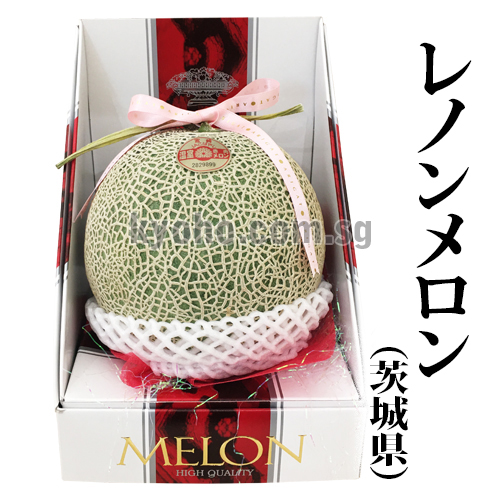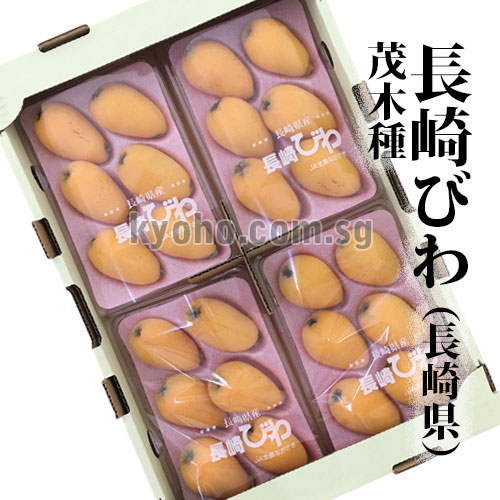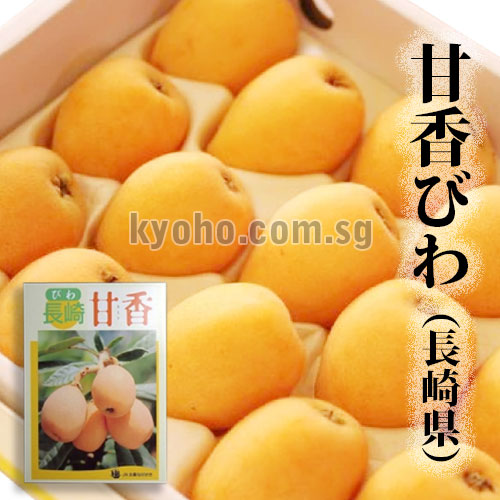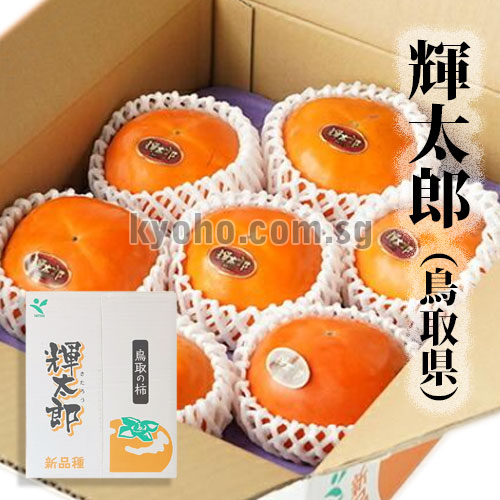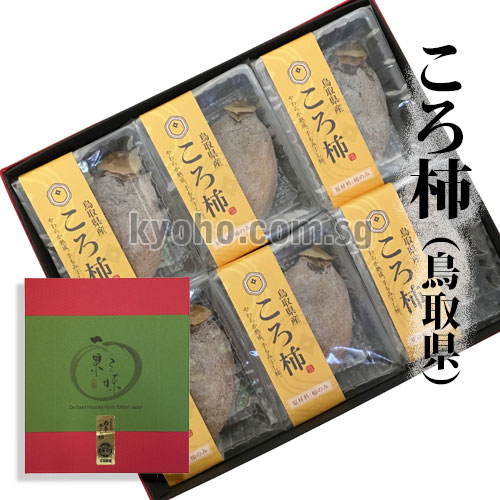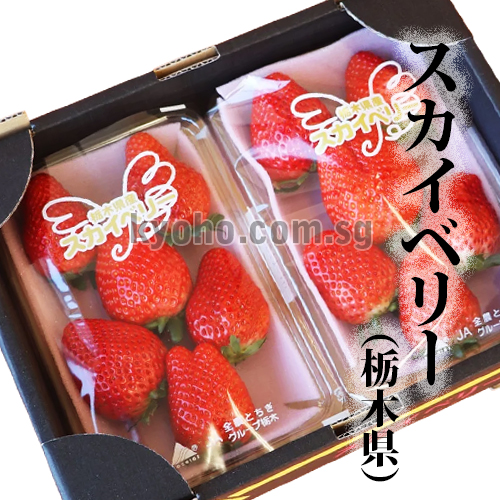
Order Time: Monday - Friday
(from 1000 hrs - 1800 hrs)
Delivery Schedule: 1 day in advance.
Please send Email: admin@kyoho.com.sg
or CALL 6884 9136 for order and enquiry.

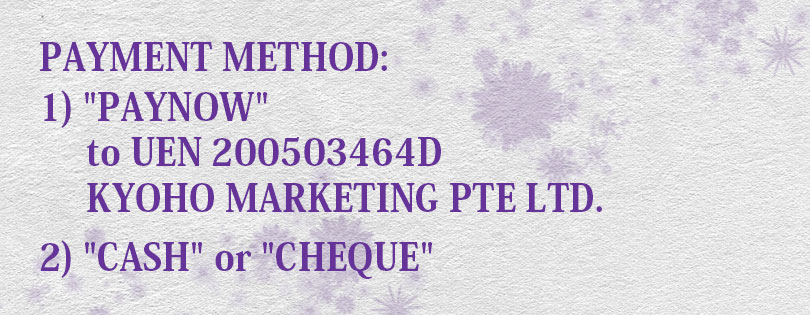

 |
 |
 |
 |
 |
 |
 |
 |
 |
 |
 |
 |
 |
 |
 |
 |
メロン(化粧箱) / |
||
 |
||
 |
 |
 |
| GF/MLN-001-a: |
GF/MLN-001-b: | GF/MLN-001-c: |
| CROWN MUSK MELON (LUXURY - YAMA GRADE) Shizuoka Prefecture with wooden box (approx 1.9kg+/pc) |
CROWN MUSK MELON (LUXURY - YAMA GRADE) Shizuoka Prefectur with wooden box (approx 1.7kg+) |
CROWN MUSK MELON (LUXURY - YAMA GRADE) Shizuoka Prefecture with wooden box (approx 1.3kg+/pc) |
 |
 |
 |
| GF/MLN-002-a: |
GF/MLN-002-b: |
GF/MLN-002-c: |
| CROWN MUSK MELON (PREMIUM GRADE - SHIRO) Shizuoka Prefecture with gift box (approx 1.7kg+/pc) |
CROWN MUSK MELON (PREMIUM GRADE - SHIRO) Shizuoka Prefecture with gift box (approx 1.3kg) |
CROWN MUSK MELON (PREMIUM GRADE - SHIRO) Shizuoka Prefecture with gift box (approx 1.1kg+/pc) |
 |
 |
 |
| GF/MLN-003: |
GF/MLN-004-a: |
GF/MLN-005: |
| CROWN MUSK MELON Shizuoka Prefecture with gift box (approx 1.3kg) |
CROWN MUSK MELON (PREMIUM GRADE- SHIRO) Shizuoka Prefecture with gift box (approx 1.5kg+/pc) |
AROMA MELON (SHIRO GRADE) Shizuoka Prefecture with gift box (approx 1.4kg/pc) Sugar level: 13˚ |
|
|
||
TIPS FOR EATING A DELICIOUS MELON |
||
 |
Push the bottom of the melon gently and if you feel slightly soft, then it has ripened well and the best time to eat it. Melons start ripening only after harvesting. Ripening speed varies individually depending on the external conditions like temperature. Melons taste even better if they are cooled in a refrigerator for 2 to 3 hours before served.
辨別是否熟到恰到好處的重點在於,以手指輕壓哈密瓜的下半部(屁股的部分),感覺有點軟的時候是最佳的品嚐時刻。 ※哈密瓜從採收之後開始變熟。依保管狀態、氣溫,以及各個哈密瓜而多少有所不同。 ※若於品嚐的2〜3小時前放進冰箱,風味更佳。 詳情請瀏覽此處。 |
|
|
|
||
桃 (化粧箱) / |
||
| Peach varieties, which can be enjoyed for a long period of time from early May until as long as September, change from one variety to the next within a week or two, with a variety of greenhouse and open-air cultivars. | ||
 |
 |
 |
| GF/PEH-001-5P: | GF/PEH-001-6P: | GF/PEH-002-4P: |
| HOUSE MOMO SAKUHIME Yamanashi Prefecture (5pcs / approx 1kg) Sugar level above 12.5° |
HOUSE MOMO SAKUHIME Yamanashi Prefecture (5pcs / approx 1kg) Sugar level above 12.5° |
HIKAWA HAKUHOU (House Grown Peach) Yamanashi Prefecture (4pcs / approx 1kg) Sugar level 11~13° |
 |
 |
 |
| GF/PEH-002-5P: | GF/PEH-002-6P: | GF/PEH-003: |
| HIKAWA HAKUHOU (House Grown Peach) Yamanashi Prefecture (5pcs / approx 1kg) Sugar level 11~13° |
HIKAWA HAKUHOU (House Grown Peach) Yamanashi Prefecture (6pcs / approx 1.5kg) Sugar level 11~13° |
HOUSE MOMO HIKAWA HAKUHOU Yamanashi Prefecture (4pcs / approx 1.5kg) |
 |
 |
 |
| GF/PEH-006: | GF/PEH-007: | GF/PEH-008: |
| HOUSE PEACH (HIKAWA HAKUHO) Saga Pefecture (4pcs / approx 1kg) |
IMARI no MOMO HIKAWA HAKUHOU (PREMIUM GRADE) Saga Prefecture (4pcs / approx 1.5kg) |
IMARI no MOMO HIKAWA HAKUHOU (PREMIUM GRADE) Saga Prefecture (5pcs / approx 1.5kg) |
 |
 |
 |
| GF/PEH-012: | GF/PEH-032-5P: | GF/PEH-032-6P: |
| TOP PREMIUM PEACHES (Wooden Box) Yamanashi Prefecture (6pcs / approx 3.5kg) |
QUEEN ENDO (House Grown Peach) Yamanashi Prefecture (5pcs / approx 1.5kg) Sugar level 11~13° |
QUEEN ENDO (House Grown Peach) Yamanashi Prefecture (6pcs / approx 1.5kg) Sugar level 11~13° |
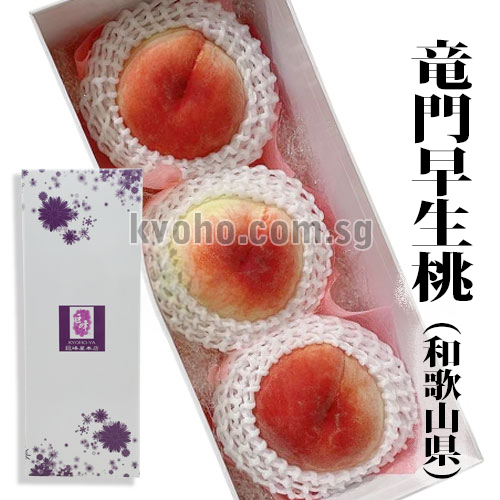 |
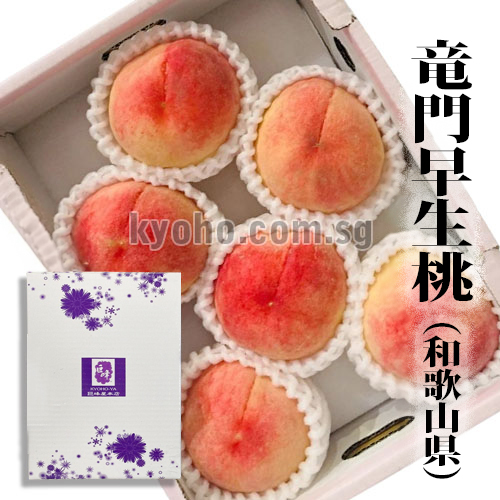 |
|
| GF/PEH-080-3P: | GF/PEH-080-6P: | |
| RYUMON WASE MOMO WakayamaPrefecture (3L / 3pcs / approx 300g+/pc) Sugar level 11°~ |
RYUMON WASE MOMO WakayamaPrefecture (2L / 6pcs approx 260g/pc) Sugar level 11°~ |
|
|
|
||
温室桃 / HOUSE PEACH |
||
A rare original variety grown only by a few farmers in Misaka-cho, Yamanashi Prefecture, a peach-growing region.Kimiko was discovered by chance as a result of a mutation at Kawai Yuran Farm in Yamanashi Prefecture. Its detailed history is unknown. The skin and pulp are yellow with a reddish part in the centre. Apricot-like aroma... The taste and texture of this peach is reminiscent of a mango, with a similar taste and flavour to that of tropical fruits. It is less acidic, with a full sweetness, and is ready to eat when its surface changes from light yellow to gradually darker yellow and turns golden yellow. |
||
 |
 |
 |
| GF/PEH-004-a: | GF/PEH-004-b: | GF/PEH-004-c: |
| HOUSE MOMO KIMIKO Yamanashi Prefecture (6pcs) |
HOUSE MOMO KIMIKO (PREMIUM - SHU GRADE) Yamanashi Prefecture (5pcs / approx 1.5kg) |
HOUSE MOMO KIMIKO (PREMIUM - SHU GRADE) Yamanashi Prefecture (6pcs / approx 1.5kg) |
|
|
||
清水白桃 / SHIMIZU HAKUTOU (WHITE PEACH) |
||
 |
 |
 |
| GF/PEH-038-3P: | GF/PEH-038-5P: | |
| SHIMIZU HAKUTOU Okayama Prefecture (3pcs / approx 900g+) Sugar level: 12°~ |
SHIMIZU HAKUTOU Okayama Prefecture (5pcs / approx 1.3kg+) Sugar level: 12°~ |
|
|
|
||
白美人 / SHIRO-BIJIN |
||
 |
 |
 |
| GF/PEH-005-5P: | GF/PEH-058-3P: | GF/PEH-058-6P: |
| SHIRO-BIJIN Yamanashi Prefecture (5pcs / approx 1kg) Sugar level above 10.5°~ |
SHIRO-BIJIN Yamanashi Prefecture (4L size / 3pcs) Sugar level: 12°~ |
SHIMIZU HAKUTOU Okayama Prefecture (5pcs / approx 1.3kg+) Sugar level: 12°~ |
|
|
||
大糖領桃 / DAITOURYOU PEACH |
||
 |
||
What is the "DAITOURYOU"?The Misaka area of Yamanashi Prefecture is a major peach-growing region with more than 600 farmers competing to produce the most popular peaches in the country.The sweetness and colour of the peaches are checked one by one using a sugar content sensor (beautiful peaches with a beautiful appearance and sweetness of 12° or more, and 13° or more after Hakuhou). Only the best quality peaches are shipped under the JA Fuefuki-Misaka brand name, 'Daitouryou'. |
||
 |
 |
 |
| GF/PEH-010-a: |
GF/PEH-010-b: |
GF/PEH-014-6P: |
| DAITOURYOU (TOP PREMIUM) Yamanashi Prefecture (3pcs / approx 380g+ per pc Sugar lebvel: 13°~ |
DAITOURYOU (TOP PREMIUM) Yamanashi Prefecture (6pcs / approx 330g+ per pc) Sugar lebvel: 13°~ |
MISAKA no DAITOURYOU (TOP PREMIUM GRADE) Yamanashi Prefecture (6pcs / approx 2.5kg) Sugar lebvel: 13°~ |
 |
 |
 |
| GF/PEH-014-5P: | GF/PEH-015: | GF/PEH-055: |
| MISAKA no DAITOURYOU (PREMIUM GRADE) Yamanashi Prefecture (5pcs / approx 380g/pc) |
MISAKA no MOMO -DAITOURYOU - KAMI NO WAZA Yamanashi Prefecture (approx 500g/pc) |
DAITOURYOU Yamanashi Prefecture (4pcs / approx 400g/pc) |
|
|
||
いちのみやプレミアム / ICHINOMIYA PREMIUM |
||
 |
 |
 |
| GF/PEH-070-3P: |
GF/PEH-070-6P: |
GF/PEH-013: |
| ICHINOMIYA PREMIUM HIKAWA HAKUHO Yamanashi Prefecture (3pcs / approx 330g+per pc) |
ICHINOMIYA PREMIUM HIKAWA HAKUHO Yamanashi Prefecture (6pcs / approx 300g+per pc) |
ICHINOMIYA PREMIUM HIKAWA HAKUHO Yamanashi Prefecture (6pcs / approx 3kg) |
|
|
||
 |
 |
 |
| GF/PEH-039-3PA: |
GF/PEH-039-3PB: | GF/PEH-039-6P: |
| HAKUTOU - WHITE PEACH (KING GRADE) Okayama Prefecture (3pcs / approx 330g+ per pc) Sugar level: 12°~ |
HAKUTOU - WHITE PEACH (KING GRADE) Okayama Prefecture (3pcs / approx 380g+ per pc) Sugar level: 12°~ |
HAKUTOU - WHITE PEACH (KING GRADE) Okayama Prefecture (6pcs / approx 300g+ per pc) Sugar level: 12°~ |
|
|
||
千代姫 / CHIYOHIME |
||
A small, cute and extremely early peach.A crossbred seedling of 'Koyohaku Peach' and 'Saotome’ was selected and bred, and the variety was registered in 1988. It is harvested and shipped earlier than the general peach harvesting period (outdoor cultivation). Because it is harvested early, it is smaller than other peaches, but it is one of the sweetest of the early peaches and has low acidity. The sugar content is slightly lower at around 11°C, but the taste is refreshing and light. The fruit is juicy while being slightly firm. Recommended for those who want to enjoy a firm texture and texture. |
||
 |
 |
 |
| GF/PEH-066-a: |
GF/PEH-066-b: |
|
| CHIYOHIME Yamanashi Prefecture (L size / 6pcs / approx 310g/pc) |
CHIYOHIME Yamanashi Prefecture (L size / 3pcs / approx 330g/pc) |
|
|
|
||
はなよめ / HANAYOME |
||
Enjoy the rare, extremely early variety HAYOYOME!This is an early variety bred and propagated by Katsuhiro Shimo in Yashiro-cho (present-day Fuefuki-shi), Yamanashi Prefecture, from a mutant tree of the Hikawa Hakuho variety, which he discovered in his garden at the end of the Showa period (1926-1989) and registered in 1995. It is an extremely early variety, available in mid-June, when the open-air peach season starts in Yamanashi, and as it grows, it turns slightly reddish pink, named after the bride whose cheeks are slightly stained. Like its pretty name, it is a little smaller in size, but has a very pleasant aroma and is full of light, elegant, sweet juice. |
||
 |
 |
 |
| GF/PEH-067: |
||
| HANAYOME Yamanashi Prefecture (8pcs / approx 2.5kg) |
||
|
|
||
日川白鳳 / HIKAWA HAKUHOU |
||
 |
||
What is the "HIKAWA HAKUHOU"?This peaches are in season from June to late July. The Hikawa Hakuhou is a peach with a dark red skin and a strong sweet flavour.The variety branched out from the Hakuhou variety in Yamanashi prefecture, and its current main production area is also in Yamanashi prefecture, which accounts for more than half of the national production. The production of the Hikkawa Hakuhou is high and it is a very popular variety. |
||
 |
 |
 |
| GF/PEH-009-3P: |
GF/PEH-009: | GF/PEH-009-6P: |
| HIKAWA HAKUHO (ITTOUSHOU - PREMIUM GRADE) Yamanashi Prefecture (3L size / 3pcs / approx 370g per pc) |
HIKAWA HAKUHOU (ITTOUSHOU - PREMIUM GRADE) Yamanashi Prefecture (6pcs / approx 300g per pc) |
HIKAWA HAKUHOU (ITTOUSHOU - PREMIUM GRADE) Yamanashi Prefecture (6pcs / approx 400g per pc) Sugar level: 13.5°~ |
 |
 |
 |
| GF/PEH-036: | GF/PEH-047: |
GF/PEH-065: |
| HIKAWA HAKUHOU Yamanashi Prefecture (6pcs / approx 300g/pc) |
ICHINOMIYA no MOMO HIKAWA HAKUHO (PREMIUM GRADE) Yamanashi Prefecture (2L size / 6pcs / approx 330g per pc) |
ICHINOMIYA no MOMO HIKAWA HAKUHO Yamanashi Prefecture (6pcs / approx 310g per pc) |
|
|
||
白鳳 / HAKUHOU (WHITE PEACH) |
||
 |
 |
|
| GF/PEH-021-6P: | GF/PEH-021-8P: | |
| HAKUHOU (House Grown Peach) Yamanashi Prefecture (6pcs / approx 1.5kg) Sugar level 11~13° |
HAKUHOU (House Grown Peach) Yamanashi Prefecture (8pcs / approx 1.5kg) Sugar level 11~13° |
|
 |
 |
 |
| GF/PEH-072-a: |
GF/PEH-072-b: |
|
| HAKUHOU ACE (WHITE PEACH) Okayama Prefecture (2L size / 6pcs / approx 330g+ per pc) |
HAKUHOU ACE (WHITE PEACH) Okayama Prefecture (3L size / 3pcs / approx 360g+ per pc) |
|
|
|
||
一桃匠 / ITTOUSHOU |
||
What is the "一桃匠 (ITTOUSHOU)"?It is a peach of the highest quality, a higher grade of "Superior" (特秀品 Tokushuhin), shipped from the JA Fuefuki Yashiro district. Each fruit is checked for sugar content and acidity using non-destructive sensors, and the fruit is carefully sorted by the eyes of skilled fruit pickers. |
||
 |
 |
 |
| GF/PEH-005: |
GF/PEH-033: |
GF/PEH-034-a: |
| HOUSE GROWN - ITTOUSHOU (Yellow Peach) (PREMIUM GRADE) Yamanashi Prefecture (3pcs / approx 1.2kg) |
HOUSE MOMO - ITTOUSHOU - HIKAWA HAKUHOU Yamanashi Prefecture (5pcs / approx 1.5kg) |
HOUSE GROWN - ITTOUSHOU- SHIRO BIJIN (White Peach) Yamanashi Prefecture (3pcs / approx 1.5kg) |
 |
||
| GF/PEH-034-c: | ||
| HOUSE GROWN - ITTOUSHOU- SHIRO BIJIN (White Peach) Yamanashi Prefecture (5pcs / approx 1.5kg) |
||
|
|
||
白桃 / HAKUTOU PEACH |
||
HAKUTOU(白桃)The Hakutou type is a traditional Japanese variety. The fruit is characterised by its large size, sweetness and slightly crunchy texture. The flesh is firmer than that of the Hakuhou type, and many of them have a bitter taste characteristic of the fruit as well as sweetness. |
||
 |
 |
 |
| GF/PEH-019: | GF/PEH-019A: | GF/PEH-020A |
| ICHINOMIYA HAKUTOU Yamanashi Prefecture (6pcs / approx 380g/pc) |
ICHINOMIYA HAKUTOU Yamanashi Prefecture (3pcs / approx 380g/pc) |
ICHINOMIYA HAKUTOU Yamanashi Prefecture (3pcs / approx 400g/pc) |
 |
 |
 |
| GF/PEH-023: | GF/PEH-024: | |
| KAWANAKAJIMA HAKUTOU Aomori Pefecture (3pcs / approx 300g/pc) |
KAWANAKAJIMA HAKUTOU (PREMIUM SHU GRADE) Aomori Prefecture (6pcs / approx 380g/pc) |
|
 |
 |
 |
| GF/PEH-038: | GF/PEH-039: | GF/PEH-041-a: |
| HAKUTOU Okayama Prefecture (2L size / 3pcs / approx 460g/pc) |
HAKUTOU Okayama Prefecture (3pcs / approx 375g/pc) |
SHIRO BIJIN (PREMIUM SHU GRADE) Yamanashi Prefecture (3L size / 6pcs / approx 380g/pc) |
 |
 |
 |
| GF/PEH-045-a: | GF/PEH-045-b: | GF/PEH-049: |
| TAMAUSAGI (PREMIUM TOKUSHU GRADE) Yamagata Prefecture (5pcs / approx 2.8kg) |
TAMAUSAGI (PREMIUM TOKUSHU GRADE) Yamagata Prefecture (6pcs / approx 2.8kg) |
KANOIWA HAKUTOU Okayama Prefecture (5pcs / approx 300g/pc) |
 |
 |
 |
| GF/PEH-050: | GF/PEH-056: | GF/PEH-058: |
| OOFUJI no ASAMA HAKUTOU Yamanashi Prefecture (6pcs / approx 310g/pc) |
MEGUMIHAKU Okayama prefecture (4pcs / approx 430g+/pc) |
SHIRO-BIJIN Yamanashi Prefecture (6pcs / approx 400g/pc) |
 |
 |
 |
| GF/PEH-059: | GF/PEH-060: | GF/PEH-061: |
| P~ICHIBAN SHINGEN RANK Yamanashi Prefecture (3pcs / approx 450g/pc) |
P~ICHIBAN SHINGEN RANK Yamanashi Prefecture (6pcs / approx 350g/pc) |
KANOIWA HAKUTOU Yamanashi Prefecture (6pcs / approx 2kg) |
 |
||
| GF/PEH-062: | ||
| KANOIWA HAKUTOU Yamanashi Prefecture (4pcs / approx 380g/pc) |
||
|
|
||
清水白桃 / SHIMIZU HAKUTOU |
||
SHIMIZU HAKUTOUShimizu Hakuto is a very elegant peach with white skin and fruit. Even if it is ripened, it does not turn red and remains white and ready to eat.The fruit is soft and juicy enough to drip the juice, and the sugar content is high. Okayama Prefecture is the main production area for Shimizu Hakuto, which is in season from late July to early August, and accounts for more than 60% of the whole country. |
||
 |
 |
 |
| GF/PEH-037: | GF/PEH-051: | GF/PEH-052: |
| SHIMIZU HAKUTOU Okayama Prefecture (L size / 6pcs / approx 400g/pc) |
SHIMIZU HAKUTOU Okayama Prefecture (6pcs / approx 340g/pc) |
SHIMIZU HAKUTOU Okayama Pefecture (5pcs / approx 450g/pc) |
|
|
||
あら川の桃 / ARAKAWA NO MOMO |
||
What it the ARAKAWA NO MOMO?Arakawa peach is a representative brand of peach produced in Momoyama-cho, Kinokawa City, Wakayama prefecture. The flesh is white with a crimson colour around the seeds.The flesh is firm and tight, with a firm texture rather than dripping juice when chewed. It is sweet enough, with low acidity and a long shelf life. |
||
 |
 |
 |
| GF/PEH-053: | GF/PEH-054: | |
| ARAKAWA NO MOMO Wakayama Prefecture (13pcs / approx 5kg/box) |
ARAKAWA NO MOMO Wakayama Prefecture (6pcs / approx 380g/pc) |
|
|
|
||
幸茜 / SACHI-AKANE |
||
 |
 |
 |
| GF/PEH-043-a: | GF/PEH-043-b: | GF/PEH-043-c: |
| ICHINOMIYA - SACHIAKANE (PREMIUM GRADE) Yamanashi Prefecture (3L size / 6pcs / approx 380g/pc) |
ICHINOMIYA - SACHIAKANE (PREMIUM GRADE) Yamanashi Prefecture (2L size / 6pcs / approx 330g/pc) |
ICHINOMIYA - SACHIAKANE (PREMIUM GRADE) Yamanashi Prefecture (3pcs / approx 380g+per pc) |
|
|
||
夢みずき / YUMEMIZUKI |
||
Yumemizuki, an original Yamanashi variety, is attracting attention as the star of the next generation.Yumemizuki is a big newcomer that is expected to become one of the leading varieties of the next generation of Yamanashi peaches. The variety was only registered in 2014 and is produced exclusively in Yamanashi Prefecture. In Yamanashi Prefecture, there is a peach called 'Asama Hakuto', which is highly praised by growers, but this peach tree has reached the end of its life span and needs to be replanted. This Yumemizuki variety has the ‘Asama Hakuto’ as its parent and the ‘Gyosei’ variety, which is famous for its high sugar content, as its other parent. It is characterised by its large size, high sugar content and extremely juicy. Its freshness can be seen in the fact that its name is derived from the image of a delicious peach that is as fresh as a dream. It started appearing on the market around 2015 and is increasing year by year. |
||
 |
 |
 |
| GF/PEH-071-a: |
GF/PEH-071-b: |
|
| YUME MIZUKI Yamanashi Prefecture (2L size / 6pcs / approx 330g per pc) |
YUME MIZUKI Yamanashi Prefecture (3L size / 6pcs / approx 380g per pc) |
|
|
|
||
白根白桃 (陽だまり) / SHIRONE HAKUTOH (HIDAMARI) |
||
What are "HIDAMARI-MOMO"?Nagano prefecture ranks third in the country in terms of peach shipments.The Kawanakajima area in the prefecture is famous as one of the best peach-growing areas in the country, with good drainage and a large temperature difference between day and night. JA Nakano uses non-destructive sensor-equipped fruit sorting machines to measure the sugar content and ripeness of the peaches and select the peaches. Peaches with a sugar content of 13 degrees or higher are branded as ‘HIDAMARI-MOMO (sunny peaches)’. |
||
 |
 |
 |
| GF/PEH-063-a:
|
GF/PEH-063-b: | GF/PEH-063-c: |
| SHIRONE HAKUTOH -HIDAMARI Nagano Prefecture (4pcs / approx 410g+/pc) |
SHIRONE HAKUTOH -HIDAMARI Nagano Prefecture (6pcs / approx 380g+/pc) |
TSUKI NO USAGI SHIRONE HAKUTOH -HIDAMARI Nagano Prefecture (6pcs / approx 380g+/pc) |
|
|
||
黄金桃 (ゴールデンピーチ) / GOLDEN PEACH |
||
This variety was accidentally born from Kawanakajima white peaches (川中島白桃), synonymous with sweet peaches.The Golden Peach has its roots in Kawanakajima white peaches (川中島白桃), a variety that was accidentally born from Kawanakajima white peaches, a variety synonymous with sweet peaches. The colour of the rind of peaches that have been bagged has a beautiful golden colour throughout. Others, like ordinary peaches, have a yellow background with red coloured areas, while others have a dark red colouring all over. The flesh of all of these peaches is a beautiful yellow, reminiscent of mangoes, as they are members of the yellow peach family. The flesh has a texture similar to that of white peaches and is slightly firm, but not as firm as the yellow peaches used for canning. They are very juicy and sweet, with a moderate acidity and a rich overall taste. |
||
 |
 |
 |
| GF/PEH-017-3P: | GF/PEH-017-6P: | GF/PEH-035: |
| OUGONTOU Yamanashi Prefecture (3pcs / approx 330g/pc) Sugar level: 12°~ |
OUGONTOU Yamanashi Prefecture (6pcs / approx 300g/pc) Sugar level: 12°~ |
OUGONTOU Yamanashi Prefecture (6pcs / approx 2.5kg) Sugar level: 12°~ |
 |
 |
 |
| GF/PEH-026: | GF/PEH-027: | GF/PEH-028: |
| KAI-KIITOU (OUTOU) Yamanashi Prefecture (6pcs / approx 380g/pc) |
KAI-KIITOU (OUTOU) Yamanashi Prefecture (3pcs / approx 380g/pc) |
KAI-KIITOU / OUTOU Yamanashi Prefecture (3pcs / pprox 400g/pc) |
 |
 |
 |
|
GF/PEH-040-6P: |
GF/PEH-040-5P: | GF/PEH-042-a: |
| OUGONTOU Yamanashi Prefecture (6pcs / approx 2.5kg) Sugar level: 14°~ |
OUGONTOU Yamanashi Prefecture (5pcs / approx 2.5kg) Sugar level: 14°~ |
OUGONTOU (PREMIUM SHU GRADE) Nagano Prefecture (3L size / 6pcs / approx 380g/pc) |
 |
 |
 |
| GF/PEH-042-b: | GF/PEH-044-a: | GF/PEH-057: |
| OUGONTOU (PREMIUM SHU GRADE) Nagano Prefecture (4L size / 3pcs / approx 400g/pc) |
OUGONTOU Yamanashi Prefecture (8pcs / approx 3.6kg) |
OUGONTOU Yamanashi Prefecture (4pcs / approx 340g/pc) |
 |
 |
 |
| GF/PEH-068-a: | GF/PEH-068-b: | GF/PEH-076: |
| OHGONTOU (GOLDEN PEACH) Yamanashi Prefecture (5pcs / approx 1.5kg) |
OHGONTOU (GOLDEN PEACH) Yamanashi Prefecture (4pcs / approx 1kg) |
OUGONTOU - HIDAMARI (GOLDEN PEACH) Nagano Prefecture (6pcs / approx 410g+per pc) |
 |
 |
 |
| GF/PEH-077-a: |
GF/PEH-077-b: | GF/PEH-077-c: |
| PRINCESS AKIRA (GOLDEN PEACH) Yamagata Prefecture (4pcs / approx 2.5kg/box) |
PRINCESS AKIRA (GOLDEN PEACH) Yamagata Prefecture (5pcs / approx 2.5kg/box) |
PRINCESS AKIRA (GOLDEN PEACH) Yamagata Prefecture (6pcs / approx 2.5kg/box) |
|
|
||
さくら白桃 / SAKURA HAKUTOH |
||
 |
 |
 |
| GF/PEH-022:
|
GF/PEH-075-a: | GF/PEH-075-b: |
| SAKURA HAKUTOU Yamanashi Prefecture (6pcs / approx 330g+ per pc) |
SAKURA HAKUTOH (PREMIUM GRADE -TOKUSHU) Yamagata Prefecture (5pcs / approx 2.5kg) |
SAKURA HAKUTOH (PREMIUM GRADE -TOKUSHU) Yamagata Prefecture (6pcs / approx 2.5kg) |
|
|
||
西王母 / SEIOUBO |
||
What are "SEIOUBO (WHITE PEACH)"?The Seiohbo is a large, rare white peach.This new peach variety is a crossbreed of the ‘Kawanakajima Hakutou’ and ‘Yuzora’ varieties and is characterised by its large, mouth-watering fruit. It is an extremely late variety in Yamagata, which is a late bloomer in peach cultivation, and is harvested as late as late September, so it can be enjoyed after the harvesting of peaches from other regions has been completed. Seioubo (Xiwangmu) is a popular Chinese goddess of longevity, and is also the highest-ranking goddess in the story of Sun Wukong. She is depicted with peaches in many legends, and Seioubo's peaches are considered to be peaches of longevity and protection against evil. |
||
 |
 |
 |
| GF/PEH-064-a: | GF/PEH-064-b: | |
| SEIOUBO (WHITE PEACH) Yamagata Prefecture (5pcs / approx 2.8kg) |
SEIOUBO (WHITE PEACH) Yamagata Prefecture (6pcs / approx 2.8kg) |
|
|
|
||
冬桃がたり / FUYU-MOMO-GATARI |
||
 |
 |
 |
| GF/PEH-029:
|
GF/PEH-030: | |
| FUYU-MOMO-GATARI (ROYAL GRADE ) Okayama Prefecture (7pcs / approx 2kg) |
FUYU-MOMO-GATARI (ROYAL GRADE) Okayama Prefecture (8pcs / approx 2kg) |
|
|
|
||
すもも・プラム (化粧箱) / |
||
It has an exquisite sweet and sour taste, like a peach and plum in one.Kiyo is a plum produced in Yamanashi Prefecture. It was bred by Mr Takao Takaishi of Nakakoma-gun through natural crossbreeding with 'Taiyo' and registered as a variety in 1996. It is a fantastic variety that was created after 20 years of trial and error in order to produce a high quality flavour. Unlike peaches, which are generally regarded as a sour fruit, the Kiyo has a good balance of acidity and sweetness, and is characterised by its size, which is the same as a peach. Because they are large and require a lot of care and attention to cultivation, they are difficult to grow and there are not so many producers, so they are treated as a high-class plum due to their rarity and good taste. Furthermore, the Kiyo is the only one in the country that is dedicated to the Ise Shrine in Mie Prefecture. The red part of the rind sometimes has a crack-like stripe called a 'ring pattern'. This is an indicator of ripeness, and those with a ring pattern are said to be well ripe and sweet. |
||
 |
 |
 |
| GF/PLM-001-a: |
GF/PLM-001-b: |
GF/PLM-001-c: |
| KIYOU PLUM (TOP QUALITY) Yamanashi Prefecture (8pcs / approx 1kg) |
KIYOU PLUM (TOP QUALITY) Yamanashi Prefecture (9pcs / approx 1kg) |
KIYOU PLUM (TOP QUALITY) Yamanashi Prefecture (10pcs / approx 1kg) |
 |
 |
 |
| GF/PLM-001-d: | GF/PLM-005-7P: |
GF/PLM-005-8P: |
| KIYOU PLUM (TOP PREMIUM) Yamanashi Prefecture (11pcs / approx 1.5kg) |
KIYOU PLUM (TOP QUALITY) Yamanashi Prefecture (8pcs / approx 1.5kg) Sugar Level 17°~ |
KIYOU PLUM (TOP QUALITY) Yamanashi Prefecture (8pcs / approx 1.5kg) Sugar Level 17°~ |
 |
 |
 |
| GF/PLM-006: | GF/PLM-007: | GF/PLM-008: |
| KIYOU PLUM (TOP PREMIUM) Yamanashi Prefecture (6pcs / approx 1.5kg) |
KIKI PLUM Nagano Prefecture (6pcs / approx 1.5kg) |
KIYOU PLUM Yamanashi Prefecture (8pcs / approx 2.2kg) |
 |
 |
 |
| GF/PLM-009: | GF/PLM-010: | GF/PLM-013: |
| KOJYU PLUM (TOP PREMIUM) Yamanashi Prefecture (8pcs / approx 2.2kg) |
AKIHIME PLUM (PREMIUM SHU GRADE) Nagano Prefecture (6pcs / approx 200g/pc) |
KIYOU PLUM Yamanashi Prefecture (6pcs) |
 |
 |
 |
| GF/PLM-015-4P: | GF/PLM-015-5P: | GF/PLM-015-6P: |
| KIYOU PLUM (TOP QUALITY) Fukuoka Prefecture (4pcs / approx 1.5kg) Sugar Level 17°~ |
KIYOU PLUM (TOP QUALITY) Fukuoka Prefecture (5pcs / approx 1.5kg) Sugar Level 17°~ |
KIYOU PLUM (TOP QUALITY) Fukuoka Prefecture (6pcs / approx 1.5kg) Sugar Level 17°~ |
 |
||
| GF/PLM-016: | ||
| PREMIUM PLUM - MOONLIGHT Yamanashi Prefecture (12pcs / approx 2kg) Sugar Level 16°~ |
||
SUMMER ANGEL (夏日天使)is a variety selected and bred by Yamanashi Prefecture in 1991 at the Yamanashi Fruit Experiment Station (Yamanashi City) to develop an original variety, by crossing Soldum with Kelsey. The variety was applied for registration in 2001 and registered in 2005.The fruit is large, weighing about 150g, with a bright red surface and soft yellow flesh, making it very juicy. They are sweet plums with a high sugar content of 15-17°C, but also have a moderate acidity in the skin, giving them a very well-balanced taste. |
||
 |
 |
|
| GF/PLM-011-b: | GF/PLM-014: |
|
| SUMMER ANGEL Yamanashi Prefecture (11pcs / approx 1.5kg) |
SUMMER ANGEL (PREMIUM GRADE) Yamanashi Prefecture (8pcs / approx 1.5kg) |
|
|
|
||
TIPS FOR EATING A DELICIOUS SUMOMO / PLUM |
||
 |
Ripe for about a week at room temperature. |
|
|
|
||
葡萄 (化粧箱) / |
||
シャインマスカット煌乃 / SHINE MUSCAT KIRAMEKINO |
||
Criteria for a Shine Muscat to be named "KIRAMEKINO"?The premium Shine Muscat Kiramekino is a new brand from JA Okayama Higashi, which produces the highest quality Muscats in Okayama.Only the highest quality products that have passed strict inspections can be called premium Shine Muscat 'Kiramekino’, with high standards, including a sugar content of 18 degrees or higher and super-sized grapes weighing 18g or more per piece. |
||
 |
 |
 |
| GF/SMG-011: | GF/SMG-012: | GF/SMG-013: |
| KIRAMEKINO (TOP PREMIUM) Okayama Prefecture (approx 830g+) |
KIRAMEKINO (TOP PREMIUM) Okayama Prefecture (approx 700g+) |
KIRAMEKINO (TOP PREMIUM) Okayama Prefecture (approx 600g+) |
 |
 |
|
| GF/SMG-019 | GF/SMG-020: | |
| KIRAMEKINO (TOP PREMIUM) Okayama Prefecture (approx 830g+) *with LED light Luxury Glass Box |
KIRAMEKINO (TOP PREMIUM) Okayama Prefecture (approx 800g) *with LED light Luxury Glass Box |
|
|
|
||
シャインマスカット 晴王® / SHINE MUSCAT - HAREOU® |
||
Hareoh® is the name of the Shine Muscat shipped by JA in Okayama Prefecture.There are three quality standards for the Shine Muscat: "Toku-shu", "Aka-shu", "Ao-shu", "Superior" and "Non-standard". Each of these has its own specific requirements, with the top-ranked 'Toku-shu' having a well-defined appearance and a sugar content of at least 18 degrees, a grain weight of at least 15g and a weight of at least 700g per bunch. |
||
 |
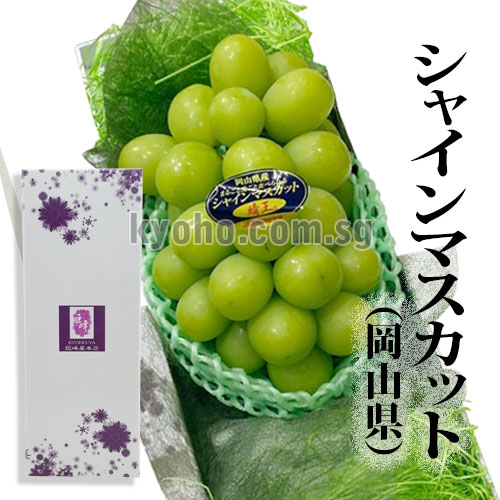 |
 |
| GF/SMG-002: |
GF/SMG-003-a: |
GF/SMG-003-d: |
| SHINE MUSCAT - HAREOU (PREMIUM GRADE - KIWAMI) Okayama Prefecture (approx 1kg) |
SHINE MUSCAT - HAREOU (PREMIUM GRADE) Okayama Prefecture (approx 700g+) |
HAREOU (PREMIUM GRADE) Okayama Prefecture (approx 500g+) |
 |
 |
 |
| GF/SMG-004-b: |
GF/SMG-007: |
GF/SMG-010-a: |
| SHINE MUSCAT - HAREOU Okayama Prefecture (approx 500g) |
SHINE MUSCAT - HAREOU (PREMIUM GRADE AO-SHU) Okayama Prefecture (approx 600g+) |
SHINE MUSCAT - HAREOU (PREMIUM GRADE AKA-SHU) Okayama Prefecture (approx 1.25kg) |
 |
 |
 |
| GF/SMG-010-b: |
GF/SMG-016: |
GF/SMG-017: |
| SHINE MUSCAT - HAREOU (PREMIUM GRADE AKA-SHU) Okayama Prefecture (approx 1kg+) |
HARUOU (PREMIUM GRADE) Okayama Prefecture (approx 550g+) |
SHINE MUSCAT - HAREOU (PREMIUM GRADE AO-SHU) Okayama Prefecture (approx 700g+) |
 |
 |
 |
| GF/SMG-021: | GF/SMG-022: | GF/SMG-023: |
| HAREOU (TOP PREMIUM GRADE - KIWAMI) Okayama Prefecture (approx 800g) *with LED light Luxury Glass Box |
HAREOU (TOP PREMIUM) Okayama Prefecture (approx 800g) *with LED light Luxury Glass Box |
HAREOU (PREMIUM SHU GRADE) Okayama Prefecture (2 bunches / approx 800g) |
|
|
||
シャインマスカット / SHINE MUSCAT |
||
A grape variety that has been successfully established and branded as a grape that can be eaten seedless and with the skin intact.The “Akitsu No.21 (安芸津21号)” and “Hakunan (白南)” grapes were registered in 2006. They were bred at the Fruit Tree Research Institute of the National Agriculture and Food Research Organisation. The parent, Akitsu No. 21, is a cross between 'Steuben (スチューベン)’ and 'Muscat of Alexandria (マスカット・オブ・アレキサンドリア)’. The Hakunan parentage is also 'Katta Kurgan (カッタ・クルガン)’ x 'Kaiji (甲斐路)’. The grandparents are all delicious grapes and have inherited the best aspects of each. These white grapes are as good as the king of grapes, the Kyoho grape. |
||
 |
 |
 |
| GF/SMG-006-5G: |
GF/SMG-006-4G: |
GF/SMG-008: |
| SHINE MUSCAT Yamanashi Prefecture (approx 500g) |
SHINE MUSCAT Yamanashi Prefecture (approx 400g) |
SHINE MUSCAT Nagano Prefecture |
 |
 |
 |
| GF/SMG-009: |
GF/SMG-024-2B: | GF/SMG-024-1B: |
| SHINE MUSCAT Yamanashi Prefecture (approx 700g) |
SHINE MUSCAT TAKUMI NO BUDOU Yamanashi Prefecture (2 bunches / approx 1kg) Sugar Level: above 20°~ |
SHINE MUSCAT TAKUMI NO BUDOU Yamanashi Prefecture (1 bunch / approx 500g) Sugar Level: above 20°~ |
|
|
||
日植ファームのシャインマスカット / frm NISSHOKU FARM |
||
 |
 |
 |
| GF/SMG-014: |
GF/SMG-015-a: |
GF/SMG-015-b: |
| SHINE MUSCAT (NISSHOKU FARM) Okayama Prefecture (approx 700g+) |
SHINE MUSCAT (NISSHOKU FARM) Okayama Prefecture (approx 830g+) |
SHINE MUSCAT (NISSHOKU FARM) Okayama Prefecture (approx 1kg+) |
 |
||
| GF/SMG-015-c: | ||
| SHINE MUSCAT (NISSHOKU FARM) Okayama Prefecture (approx 1.25kg+) |
||
|
|
||
瀬戸ジャイアンツ / SETO GIANTS |
||
Also known as "Momotaro grapes (桃太郎ぶどう)", this is a superb product!Seto Giants grapes were bred in 1979 by Mr Hanazawa of the Hanazawa Grape Research Institute in Okayama, Japan, by crossing 'Gusar Color (グザルカラー) ' and 'Neo Muscat (ネオ・マスカット) '. The grapes are very large and have a high sugar content. It is characterised by low acidity and poor aroma, but has a good texture and can be eaten with the skin. Production is low and rare throughout the country. It is popular as a luxury grape and is sold as a gift at fruit shops. The grapes are also characteristically shaped, and are called Momotaro grapes in reference to the legend of Momotaro handed down in Okayama. Incidentally, the name Seto Giants is said to have originated from a baseball enthusiast Mr Hanazawa of the Hanazawa Grape Research Institute in Okayama Prefecture, who bred the grape. |
||
 |
||
| GF/SGG-001: |
||
| SETO GIANTS (MOMOTARO BUDO) Okayama Prefecture (approx 900g) |
||
|
|
||
オーロラブラック / AURORA BLACK |
||
Large jet-black grape born in Okayama Prefecture.This variety was selected and bred at the Agricultural Research Institute of the Okayama Prefectural Agriculture, Forestry and Fisheries Centre in 1983 from seedlings produced from natural crosses of Aurora Red, and was registered as a variety in February 2003. In Okayama Prefecture, the area under cultivation is expanding as a next-generation black grape variety after Kyoho and Pione. It has no seeds and its flesh is well compacted, with a sugar content of 17-18° C, almost as high as that of Pione and Fujitoshi. It is a grape that is appreciated as a gift because of its sweetness and fragrance, but its production is low and it is a rare grape that is rarely seen. |
||
 |
 |
 |
| GF/ORG-002:
|
GF/ORG-003:
|
|
| AURORA BLACK Okayama Prefecture (approx 550g+) |
AURORA BLACK (PREMIUM GRADE- AKA-SHU) Okayama Prefecture (approx 700g+) |
|
|
|
||
デラウェア & キングデラ / DELAWARE & KING DELA |
||
Rare and highly sought-after variety for grape lovers.
|
||
 |
 |
 |
| DWG-001: | DWG-002: | DWG-003-4P: |
| DELAWARE Yamanashi Prefecture (12 bunches / approx 2kg) Sugar level 18°~ |
DELAWARE Shimane Prefecture (11 bunches / approx 2kg) Sugar level 18°~ |
DELAWARE Osaka Prefecture (4 packs / approx 1.2kg) Sugar level 18°~ |
 |
||
| DWG-003-1P: | ||
| DELAWARE Osaka Prefecture (approx 300g) Sugar level 18°~ |
||
 |
 |
|
| GF/KDWG-001: | KDWG-001: | |
| KING DELA (KING DELAWARE) Yamanashi Prefecture (5-6 bunches / approx 1.5kg) |
KING DELA (KING DELAWARE) Yamanashi Prefecture (2 bunches / approx 400g) Sugar level avobe 20° |
|
|
|
||
ニューピオーネ/ NEW PIONE |
||
Pione has "Kyoho" as its mother and "Cannon Hall Muscat" as its fathPione is a large, purple-black grape variety with Kyoho as its mother and Cannon Hall Muscat (a tetraploid variant of Muscat of Alexandria with a strong Muscat flavour and good taste) as its father. It was bred by Shizuoka Prefecture grape breeder Hideo Igawa and the name was registered in 1973. It was initially named "Pioneer", but before the variety was registered, the name was changed to "Pioneer", which also means "pioneer" in Italian. It was registered under this name. Because they look so similar, Kyoho and Pione are often mistaken for each other, but they have a high sugar content and inherit the characteristics of Muscat, which gives them a fruity, refreshing taste with a hint of acidity. Pione is originally a seeded grape, but when it was developed by Okayama Prefecture to differentiate it from the seeded Pione, it was named 'New Pione', and is now described as 'Pione (ピオーネ)’, 'New Pione (ニューピオーネ)’ or ‘Seedless Pione (種無しピオーネ)’, as seedless cultivation using gibberellin treatment has become the mainstream. |
||
 |
 |
 |
| GF/PNG-001-a: |
GF/PNG-001-b: |
GF/PNG-008: |
| NEW PIONE Okayama Prefecture (approx 1kg) Sugar Level: 18~20° |
NEW PIONE Okayama Prefecture (approx 830g+) Sugar Level: 18~20° |
NEW PIONE Okayama Prefecture (approx 700g+) |
 |
 |
|
| GF/PNG-009: |
GF/PNG-010: | |
| NEW PIONE Okayama Prefecture (approx 600g+) |
NEW PIONE Okayama Prefecture (approx 450g) |
|
|
|
||
ピオーネ/ PIONE |
||
Pione has "Kyoho" as its mother and "Cannon Hall Muscat" as its fathPione is a large, purple-black grape variety with Kyoho as its mother and Cannon Hall Muscat (a tetraploid variant of Muscat of Alexandria with a strong Muscat flavour and good taste) as its father. It was bred by Shizuoka Prefecture grape breeder Hideo Igawa and the name was registered in 1973. It was initially named "Pioneer", but before the variety was registered, the name was changed to "Pioneer", which also means "pioneer" in Italian. It was registered under this name. Because they look so similar, Kyoho and Pione are often mistaken for each other, but they have a high sugar content and inherit the characteristics of Muscat, which gives them a fruity, refreshing taste with a hint of acidity. Pione is originally a seeded grape, but when it was developed by Okayama Prefecture to differentiate it from the seeded Pione, it was named 'New Pione', and is now described as 'Pione (ピオーネ)’, 'New Pione (ニューピオーネ)’ or ‘Seedless Pione (種無しピオーネ)’, as seedless cultivation using gibberellin treatment has become the mainstream. |
||
 |
 |
 |
| GF/PNG-002: | GF/PNG-011: | GF/PNG-012: |
| PIONE from YAME (SEEDLESS) Fukuoka Prefecture (approx 600g) Sugar Level: 18°~ |
PIONE from YAME (SEEDLESS) Fukuoka Prefecture (approx 550g) Sugar Level: 18°~ |
PIONE from YAME (SEEDLESS) Fukuoka Prefecture (approx 500g) Sugar Level: 18°~ |
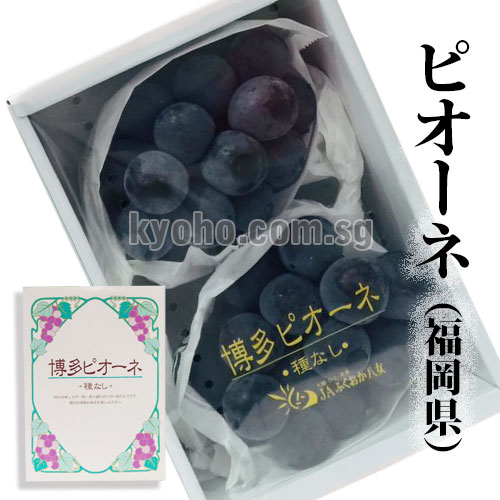 |
||
| GF/PNG-005: | ||
| PIONE Fukuoka Prefecture (approx 550g) |
||
 |
 |
|
| GF/PNG-003: | GF/PNG-004: | |
| PIONE (PREMIUM GRADE) Kagawa Prefecture (approx 500g) |
PIONE (PREMIUM GRADE - AKA SHU) Yamanashi Prefecture (approx 800g) |
|
 |
 |
 |
| GF/PNG-006: | GF/PNG-007: | GF/PNG-013: |
| PIONE Nagano Prefecture (approx 700g+) |
PIONE (SEEDLESS) Nagano Prefecture (approx 500g+) |
PIONE (SEEDLESS) Yamanashi Prefecture (approx 500g) Sugar Level: 18°~ |
|
|
||
巨峰 / KYOHO |
||
Kyoho is the king of grapes!It was created in 1942 by Mr Yasushi Ōinoue Yasushi of the Ōinoue Agricultural Research Institute by crossing the 'Ishiharawase' variety with the European variety 'Centennial' (a large tetraploid branch variety of the European grape 'Rozaki'), and in 1955 the trademark It was registered as a trademark in 1955 and became well-known. The trademark name is 'Kyoho' and the variety name is 'Ishihara Centennial’. Until then, most grapes were small and acidic, and when the Kyoho grape was introduced, people were very surprised by its huge grapes and strong sweetness. Each grape weighs 10-12g, and a large bunch can weigh up to 600g. However, the bigger and heavier a bunch of grapes is, the better. It is said that the sugar content is proportional to the number of grapes in a bunch, and the fewer the grapes, the sweeter the grapes. Despite the rapid emergence of new grape varieties, the Kyoho grape has long enjoyed a strong popularity. Recently popular varieties such as 'Nagano Purple' and 'Pione' were developed from the Kyoho grape. Incidentally, the grape is named Kyoho after Mount Fuji, which can be seen from the research centre where it was developed. |
||
 |
 |
 |
| GF/KHG-001: |
GF/KHG-002: |
GF/KHG-003: |
| KYOHO Yamanashi Prefecture (approx 600g+) |
KYOHO Fukuoka Prefecture (approx 600g+) |
KYOHO (PREMIUM GRADE) Yamanashi Prefecture (approx 500g) |
 |
 |
 |
| GF/KHG-004-a: |
GF/KHG-004-b: |
GF/KHG-005: |
| FUEFUKI TAKUMI NO BUDOU - SEEDLESS KYOHO Yamanashi Prefecture (2 bunches / approx 800g) |
FUEFUKI TAKUMI NO BUDOU - KYOHO Yamanashi Prefecture (approx 500g) |
KYOHO from YAME (SEEDLESS) Fukuoka Prefecture (approx 550g+) Sugar level 18~20° |
 |
 |
 |
| GF/KHG-006: |
GF/KHG-007: |
GF/KHG-009: |
| KYOHO Fukuoka Prefecture (approx 550g+) |
KYOHO (SEEDLESS) Nagano Prefecture (approx 700g+) |
KYOHO Fukuoka Prefecture (approx 800g) |
|
|
||
ルビーロマン/ RUBY ROMANWORLD NO.1 BIGGERS GRAPES |
||
The highest grape, perfected over a period of 14 yrs."I want big, red grapes!In order to fulfil the wishes of grape farmers, in the spring of 1995, the Sand Dune Agricultural Research Centre of the Ishikawa Prefectural Agricultural Research Centre sowed 400 seeds from a large black grape called 'Fujiminori' in a corner of a test plot. The young trees, which were carefully nurtured with great care, began to bear fruit around 1997. However, only four of the 400 trees bore red berries. From among these, the 'Ruby Roman' was selected after repeated diligent research into taste, colour, quality such as cluster and grain size, and ease of cultivation. |
||
 |
 |
 |
| GF/RM-001: | GF/RM-002: | GF/RM-003: |
| RUBY ROMAN (PREMIUM GRADE) Ishikawa Prefecture (approx 900g) *with LED light Luxury Glass Box |
RUBY ROMAN Ishikawa Prefecture (approx 800g) *with LED light Luxury Glass Box |
RUBY ROMAN (PREMIUM AKA-SHU) Ishikawa Prefecture (approx 800g) *with LED light Luxury Glass Box |
 |
 |
 |
| GF/RM-004: | GF/RM-005: | GF/RM-006: |
| RUBY ROMAN (PREMIUM -SHU GRADE) Ishikawa Prefecture (approx 700g) *with LED light Luxury Glass Box |
RUBY ROMAN (PREMIUM -SHU GRADE) Ishikawa Prefecture (approx 600g) *with LED light Luxury Glass Box |
RUBY ROMAN JERRY Ishikawa Prefecture (approx 125gx8pcs) |
|
|
||
ナガノパープル / NAGANO PURPLE |
||
High sugar content, large grapes, seedless and can be eaten with the skin!This is a large, seedless black grape variety, born from the crossbreeding of Kyoho and Rizamat and registered as a variety in 2004. It has a sweetness that reaches a sugar content of 18-21°C and a rich taste similar to that of Kyoho grapes, and because it has no seeds, you can eat it skin and all. The crispy texture of the rind also enhances the grape's umami. These high-sugar grapes have exploded in popularity due to their delicious taste. Wash them quickly with water and eat them whole. Its thin skin means that it can be eaten whole. The skin of black grapes contains polyphenols, which are said to be good for your health, so eating the whole skin is a good way to consume nutrients. The white powder on the rind is a natural ingredient produced by the grape, so it is safe to put in the mouth. |
||
 |
 |
 |
| GF/NPG-001: |
GF/NPG-002: |
GF/NPG-003: |
| NAGANO PURPLE (PREMIUM SHU GRADE) Nagano Prefecture (approx 550g+) |
NAGANO PURPLE (PREMIUM SHU GRADE) Nagano Prefecture (approx 550g+) |
NAGANO PURPLE (PREMIUM SHU GRADE) Nagano Prefecture (approx 550g+) |
|
|
||
クイーンルージュ / QUEEN ROUGE GRAPES |
||
Queen Rouge made its market debut in 2021.This grape is bred at the Nagano Prefectural Fruit Tree Experiment Station in Suzaka, from parents Shinemuscat and Unicorn.The variety will be registered in 2019 and first shipped in 2021, but currently it can only be grown in Nagano prefecture. Production is still low, but it is a high-end grape that is treated on the same level as the Shine Muscat. It has a high sugar content of 20-21 degrees, which is equal to or higher than that of the Shine Muscat and Nagano Purple. Like these two varieties, it is seedless and has a thin skin, so it can be eaten with its skin. |
||
 |
||
| GF/QRG-001: | ||
| QUEEN ROUGE Nagano Prefecture (approx 700g+) |
||
|
|
||
クイーンニーナ / QUEEN NINA GRAPES |
||
Queen Nina, a new red grape variety that was only registered as a variety in 2011.It is characterised by its firm flesh and wonderfully clear ruby-coloured skin. It is a large but seedless variety with high sugar content and good taste, and is steadily growing as a popular variety. |
||
 |
 |
 |
| GF/QNG-001: | GF/QNG-002: | GF/QNG-003: |
| QUEEN NINA (SEEDLESS) Nagano Prefecture (approx 700g+) |
QUEEN NINA (SEEDLESS) Nagano Prefecture (approx 410g+) |
QUEEN NINA (SEEDLESS) Nagano Prefecture (approx 700g+) |
|
|
||
藤稔 / FUJIMINORI GRAPES |
||
'Fujiminori' is considered 'one of the world's largest black grapes' due to the size of its grapes.It is the parent variety of Ruby Roman.Yamanashi prefecture is known as a 'fruit kingdom', and the Fuefuki area in particular is one of the best producers of high-quality fruit in Japan. The climate, with its extreme temperature differences, well-drained fertile soil and clean water, is ideal for growing grapes. The grape Fujiminori, which is carefully hand-picked by skilled growers, is a gem of the pride of the famous Fuefuki region. *Fujiminori is a variety that tends to fall off in bunches. Although every effort has been made to pack the grapes, we ask for your understanding that this is due to the nature of the grapes. |
||
 |
 |
 |
| GF/FMG-001: | GF/FMG-002: | |
| FUJIMINORI Yamanashi Prefecture (3 bunches / approx 2.5kg) |
FUJIMINORI Yamanashi Prefecture (approx 600g) |
|
|
|
||
甲斐のくろまる / KAI NO KUROMARU |
||
'Kai no Kuromaru' is an original variety created by Yamanashi Prefecture and registered as a variety in 2013.The name is derived from the fact that it was born in Yamanashi, the country of Kai, and that the rind is black with excellent colouring and the grains are round in shape.The rind is easily coloured purple-black and the skin is medium thick and easy to peel. It is also characterised by its dark colour and anthocyanin content, which is higher than that of Kyoho grapes and black beets, and its sugar content of around 18% and slightly lower acidity of 0.6% make it a sweet grape with a good taste. |
||
 |
||
| GF/KG-001: | ||
| KUROMARU Yamanashi Prefecture (approx 500g) |
||
|
|
||
富士の輝き / FUJI NO KAGAYAKI |
||
Fuji no Kagayaki, also known as Black Shine Muscat.Original in-house developed variety of Shimura Grape Research Institute, Yamanashi. (Fuefuki-city, Yamanashi Prefecture, is the undisputed home of grapes, ranking first in Japan in terms of grape and peach harvest).This red grape variety is a crossbreed of the Shine Muscat and Wink varieties and is seedless and can be eaten with the skin. It is characterised by its rich, full-bodied sweetness and Kyoho-like strength compared to Shine muscat, and is a dream grape that is eagerly awaited by growers and users as the next generation of Shine muscat. |
||
 |
||
| GF/BSMG-001: | ||
| FUJI NO KAGAYAKI (BLACK SHINE MUSCAT) Yamanashi Prefecture (approx 700g) |
||
|
|
||
梨 (化粧箱) / |
||
The Nansui pear offers the full enjoyment of the sweetness characteristic of pears.A cross between the Echigo and Shinsui varieties, this red pear was registered as a variety in 1990 and was born in Nagano Prefecture.The "Minami(南)” refers to the fact that it was born at the Nanshin Agricultural Experiment Station, while the "Mizu(水)” was named "Nansui(南水)” in the hope that it would grow into a lush pear like its parent variety, "Shinsui(新水)”. It is also hoped that the pears will be as fresh as Shinsui and Hosui, which is also popular for its abundance of freshness. The average sugar content of pears is said to be 10 degrees, but the average sugar content of Nansui pears is 14-15 degrees. Despite its high sugar content, it contains almost no acidity, allowing the unique sweetness of the pear to be enjoyed to the full. |
||
 |
 |
 |
| GF/PER-001:
|
GF/PER-002:
|
GF/PER-028: |
| NANSUI PEAR Nagano Prefecture (6pcs / approx 350g/pc) |
NANSUI PEAR Ishikawa Prefecture (3pcs / approx 350g/pc) |
NANSUI Nagano Prefecture (3pcs / approx 500g/pc) |
 |
 |
 |
| GF/PER-003:
|
GF/PER-016: | GF/PER-017: |
| SHINKANSEN PEAR (PREMIUM GRADE) Tottori Prefecture (3pcs / approx400g/pc) |
SHINKANSEN PEAR (FARM DIRECT / PREMIUM GRADE - AKASHU) Tottori Prefecture (4pcs / approx 2kg) |
SHINKANSEN PEAR (FARM DIRECT / PREMIUM GRADE - AKASHU) Tottori Prefecture (3pcs / approx 400g/pc) |
 |
 |
 |
| GF/PER-005: | GF/PER-006: | |
| AKIZUKI PEAR Oita Prefecture (3pcs / approx 500g/pc) |
ATAGO NASHI (PREMIUM GRADE) Okayama Prefecture (5pcs / approx 4kg) |
|
 |
 |
 |
| GF/PER-007: | GF/PER-008: | |
| OUSHU NASHI (Farm Direct / PREMIUM GRADE) Tottori Pefecture (3pcs / approx 1.8kg) |
OUSHU NASHI (Farm Direct / PREMIUM GRADE) Tottori Prefecture (2pcs / approx 2kg) |
|
 |
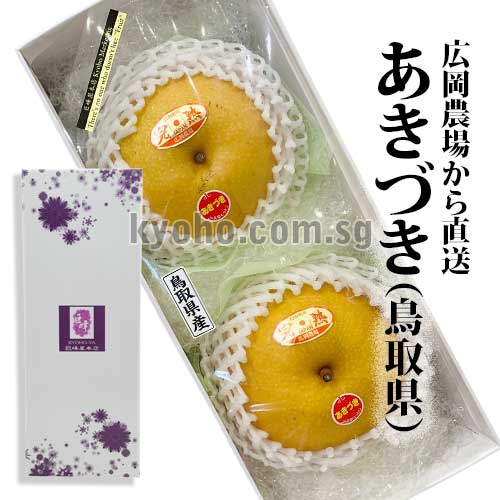 |
 |
| GF/PER-026: | GF/PER-027: | GF/PER-029: |
| AKIZUKI (FARM DIRECT) Tottori Prefecture (4pcs / approx 2.5kg) |
AKIZUKI (FARM DIRECT) Tottori Prefecture (2pcs / approx 620g/pc) |
AKIZUKI (FARM DIRECT) Tottori Prefecture (2pcs / approx 850g/pc) |
 |
 |
 |
| GF/PER-018: | GF/PER-019: | GF/PER-030: |
| SHINKOU PEAR (FARM DIRECT) Tottori prefecture (5pcs / approx 2kg) |
SHINKOU PEAR (FARM DIRECT) Tottori prefecture (3pcs / approx 500g/pc) |
SHINKOH (FARM DIRECT) Tottori Prefecture (3pcs / approx 620g/pc) |
 |
||
| GF/PER-031: | ||
| SHINKOH (FARM DIRECT) Tottori Prefecture (4pcs / approx 620g/pc) |
||
 |
 |
 |
| GF/PER-009: | GF/PER-021: | GF/PER-022: |
| KOUSUI-NASHI Saga Prefecture (6pcs / approx 2.5kg) |
KOUSUI-NASHI Kumamoto Prefecture (4L size / 6pcs / approx 410g/pc) |
KOUSUI-NASHI Kumamoto Prefecture (5L size / 3pcs / approx 500g/pc) |
 |
 |
|
| GF/PER-023: | GF/PER-024: | |
| NATSU SAYAKA (FARM DIRECT) Tottori Prefecture (3pcs / approx 410g/pc) |
NATSU SAYAKA (FARM DIRECT) Tottori Prefecture (6pcs / approx 350g/pc) |
|
南水 / NANSUI |
||
 |
 |
|
| GF/PER-035-a:
|
GF/PER-035-b:
|
|
| NANSUI Ishikawa Prefecture (6pcs / approx 410g per pc) |
NANSUI Ishikawa Prefecture (3pcs / approx 500g per pc) |
|
二十世紀 / NIJISSEIKI |
||
 |
 |
|
| GF/PER-014: | GF/PER-015: | |
| NIJISSEIKI (FARM DIRECT) Tottori Prefecture (5pcs / approx 400g/pc) |
NIJISSEIKI (FARM DIRECT / PREMIUM GRADE - AKA SHU) Tottori Prefecture (3pcs / approx 500g/pc) |
|
 |
 |
 |
| GF/PER-036-a: | GF/PER-036-b: | |
| NIJISSEIKI Kyoto Prefecture (6pcs / approx 350g per pc) |
NIJISSEIKI Kyoto Prefecture (3pcs / approx 410g per pc) |
|
秋月 / AKIZUKI |
||
 |
||
| GF/PER-037: | ||
| AKIZUKI Ishikawa Prefecture (3pcs / approx 500g per pc) |
||
新興 / SHINKOH |
||
 |
 |
|
| GF/PER-039: | GF/PER-040: | |
| SHINKOH Kyoto Prefecture (3pcs) |
SHINKOH Kyoto Prefecture (3pcs) |
|
|
|
||
ラ・フランス / LA FRANCE |
||
 |
 |
 |
| GF/PER-020: | GF/PER-025: | PER-004: |
| LA FRANCE (WESTERN PEAR) Tottori Prefecture (3L size / 6pcs) |
LA FRANCE (WESTERN PEAR) Nagano Prefecture (4pcs / approx 400g/pc) |
LA FRANCE (WESTERN PEAR) Yamagata Prefecture (M size / 4pcs) |
 |
 |
 |
| GF/PER-038-a: | GF/PER-038-b: | GF/PER-042-6P: |
| LA FRANCE Yamagata Prefecture (3L size / 6pcs) |
LA FRANCE Yamagata Prefecture (L size / 4pcs / approx 410g per pc) |
SUPER LA FRANCE Yamagata Prefecture (5 pcs& 6pcs) Sugar Level: 14˚~ |
|
|
||
りんご (化粧箱) / |
||
'An apple a day is enough to keep the doctor away'. |
||
 |
 |
|
| GF/APL-001-3P: | GF/APL-001-6P: | |
| SANFUJI APPLE (High Sugar Level / 高糖度) Aomori Prefecture (3pcs / approx 350g+ per pc) |
SANFUJI APPLE (High Sugar Level / 高糖度) Aomori Prefecture (6pcs / approx 350g+ per pc) |
|
 |
 |
|
|
GF/APL-032-6P: |
GF/APL-032-3P: |
|
| KOUTOUDO SAN FUJI (High Sugar Content) Aomori Prefecture (6pcs / 350g+per pc) |
KOUTOUDO SAN FUJI (High Sugar Content) Aomori Prefecture (63pcs / 450g+per pc) |
|
 |
 |
|
| GF/APL-002-3P: | GF/APL-002-6P: | |
| OHRIN Aomori Prefecture (3L size / 3pcs) |
OHRIN Aomori Prefecture (3L size / 6pcs) |
|
 |
 |
 |
| GF/APL-003: | GF/APL-004-3P: | GF/APL-004-6P: |
| JONAGOLD Aomori Prefecture (3L size / 3pcs) (4L size / 3pcs) |
SHINANO GOLD (High Sugar Content) Aomori Prefecture (3pcs / 450g per pc) |
SHINANO GOLD (High Sugar Content) Aomori Prefecture (6pcs / 350g per pc) |
 |
 |
 |
| GF/APL-005: | GF/APL-006: | GF/APL-007: |
| SHINANO SWEET Aomori Prefecture (3L size / 3pcs) |
KIOU RINGO Aomori Prefecture (3pcs / approx 350g+ per pc) |
SAN MEIGETSU Aomori Prefecture (3L size / 3pcs) |
 |
 |
 |
| GF/APL-013-a: | GF/APL-022-a: | GF/APL-022-b: |
| SAN MEIGETSU & SAN FUJI (FARM DIRECT) Nagano Prefecture (6pcs) |
MITSU BOSHI (SAN FUJI) Aomori Prefecture (6pcs) |
MITSU BOSHI (SAN FUJI) Aomori Prefecture (3pcs) |
The eldest of the three Nagano apple brothers*The flesh is yellowish-white and hard with a firm, crunchy texture. It is very juicy and sweet with sufficient acidity to give it an overall sweet and sour apple flavour. The aroma is also strong enough.*The Akibae is called the "Three Apple Brothers" of Nagano Prefecture, together with the "Shinano Sweet" and "Shinano Gold" apples, as apples produced in Nagano Prefecture. The "Three Apple Brothers" is a registered trademark of the National Federation of Agricultural Cooperatives. |
||
 |
 |
 |
| GF/APL-014-a: | GF/APL-014-b: | |
| SAN AKIBAE (FARM DIRECT) Nagano Prefecture (6pcs / approx 350g+ per pc) |
SAN AKIBAE (FARM DIRECT) Nagano Prefecture (3L size / 3pcs / approx 350g+ per pc) |
|
The reddish part of the apple is produced depending on the amount of sunlightThe Sun Meigetsu variety was originally a Gunma Meigetsu apple (selected by crossing 'Fuji' with 'Akagi' and registered as a variety in 1991), which originated in Gunma Prefecture, and was grown in Azumino, Nagano Prefecture, using the dwarfing method (a cultivation method in which apple trees are grown small so that the sun's rays hit the entire tree).Like 'San Fuji', 'San' also means sun. Generally, apples are grown in bags to improve their appearance, but in Nagano Prefecture, apples are grown without bags to enhance their taste rather than their appearance, so they are exposed to more sunlight, which gives them a much stronger sweetness. |
||
 |
 |
 |
| GF/APL-015-a: | GF/APL-015-c: | |
| SAN MEIGETSU (FARM DIRECT) Nagano Prefecture (6pcs / approx 350g+ per pc) |
SAN MEIGETSU (FARM DIRECT) Nagano Prefecture (4L size / 3pcs) |
|
Second of the three Nagano apple brothers*A cross between Fuji and Tsugaru, bred at the Nagano Prefectural Fruit Tree Experiment Station, it was applied for registration in 1994, 16 years after the cross, and registered two years later in 1996.The fruit is large, weighing around 350g, with high juice content and, as its name suggests, a moderate sweetness and low acidity. *Together with Akibae and Shinano Gold, it is known as Nagano Prefecture's "Three Apple Brothers". The 'Three Apple Brothers' is a registered trademark of the National Federation of Agricultural Cooperatives. |
||
 |
 |
 |
| GF/APL-016-a: | GF/APL-016-b: | |
| SAN SHINANO SWEET (FARM DIRECT) Nagano Prefecture (6pcs / approx 350g+ per pc) |
SAN SHINANO SWEET (FARM DIRECT) Nagano Prefecture (3L size / 3pcs / approx 350g+ per pc) |
|
 |
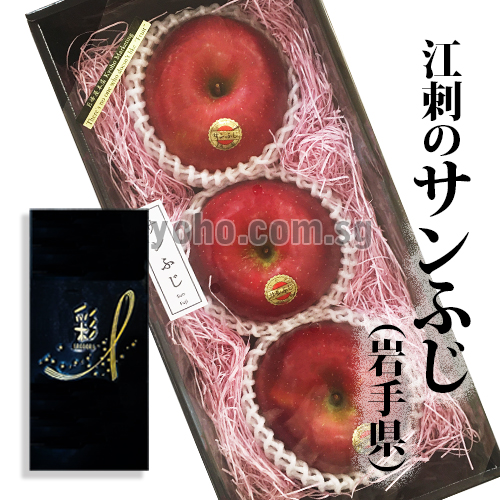 |
 |
| GF/APL-033-a: | GF/APL-033-b: | GF/APL-033-c: |
| ESASHI NO SAN FUJI with honey (Highly Rated) Iwate Prefecture (2L size / 6pcs) (L size / 6pcs) |
ESASHI NO SAN FUJI with honey (Highly Rated) Iwate Prefecture (3L size / 3pcs) |
ESASHI NO SAN FUJI with honey (Highly Rated) Iwate Prefecture (4L size / 3pcs) |
|
|
||
IWATE NO HARUKA - FUYUKOI (PREMIUM GRADE)Iwate Junjo Premium "Fuyu Koi" (Haruka) about 2.5kg 8-11 balls Shipped sequentially from mid-December. The taste of first love that will be delivered to you.Apples grown by the Iwate Touken Kenkyukai, which has outstanding cultivation techniques. ”Iwate Junjo Premium Fuyukoi" is made with only selected balls with a sugar content of 16 degrees or higher and a honey content index of 3.0 or higher. |
||
 |
 |
 |
| GF/APL-008-a: | GF/APL-008-b: | |
| IWATE NO HARUKA - FUYUKOI (PREMIUM GRADE) Iwate Prefecture (10pcs / approx 2.5kg) |
IWATE NO HARUKA - FUYUKOI (PREMIUM GRADE) Iwate Prefecture (3pcs / approx 250g/pc) |
SUGAR CONTENT 16˚ OR MORE |
ESASHI RINGO (SANFUJI)"Esashi apples" produced in the Esashi area of Oshu City were sold for the first time at the central wholesale market in Morioka in the first year of Reiwa, with a record high price of 1.4 million yen per box (50,000 yen per apple !?), and in recent years it is the highest-end brand that has dominated the top. |
||
 |
 |
 |
| GF/APL-009-6P: | GF/APL-009-3P: | |
| ESASHI RINGO (SANFUJI) Iwate Prefecture (6pcs / approx 400g+/pc) |
ESASHI RINGO (SANFUJI) Iwate Prefecture (3pcs / approx 450g+/pc) |
SUGAR CONTENT 14˚ OR MORE |
SEKAI-ICHI RINGO (BEST IN THE WORLD)The flesh is dense and slightly firm. There is moderate acidity in the sweetness, and it contains a lot of fruit juice and has a good taste. The large balls have an impact on the appearance and are satisfying to eat. However, the ones that are too big seem to have a slightly inferior shelf life.The name "World's Best" is said to have originated from the fact that it was said to be "the best apple in the world" because of its delicious taste and large size. |
||
 |
 |
 |
| GF/APL-018-a: | GF/APL-018-b: | |
| SEKAI-ICHI (BEST IN THE WORLD) Aomori Prefecture (9pcs / approx 5kg) |
SEKAI-ICHI (BEST IN THE WORLD) Aomori Prefecture (2pcs / approx 550g/pc) |
|
Jinpachi apples are grown on the slopes of the mountains in Hiraga Town, Aomori Prefecture.In November, it begins to snow in Tsugaru, and it is not uncommon for the temperature to drop below 0°C .It is said that the lower the temperature, the more the honey of Sunfuji will enter, but the danger of freezing increases when the temperature is below freezing. It is only the eyes and experience of the craftsmen that determine the timing. The important thing is to delay the harvest until the last minute when the snow piles up , and just wait patiently. The feature of Jinpachi Ringo Mikka is that it has a sugar content of 13 degrees or higher and is rich in honey. *Because it is a natural product, there are variations in how the honey is added. |
||
 |
 |
 |
| GF/APL-028-a: | GF/APL-028-b: | |
| JINPACHI RINGO - MITSUKA (SANFUJI) Aomori Prefecture (6pcs / approx 350g+/pc) |
JINPACHI RINGO - MITSUKA (SANFUJI) Aomori Prefecture (3pcs / approx 350g+/pc) |
SUGAR CONTENT 13˚ OR MORE |
Wase-Fuji is an early ripening strain of Fuji AppleIt is a mutation of the Fuji variety, and although it looks and tastes similar to Fuji, it is harvested a month earlier than Fuji, hence the name ‘Wase-Fuji (early fuji)’.Wase-Fuji is a generic name for a number of varieties, including 'Hirosaki Fuji', 'Benishogun', 'Kourin’, 'Ryouka no Season', 'Honoka' and 'Yataka'. The representative early Fuji variety 'Hirosaki Fuji' has a similar taste to 'Fuji', with a high sugar content and a high honey content, making it a popular variety with slightly softer flesh and less acidity than 'Fuji'. |
||
 |
 |
 |
| GF/APL-030: | APL-021: | |
| WASE-FUJI Aomori Prefecture (2L size / 6pcs) |
WASE-FUJI Aomori Prefecture (2L size / 2pcs) |
|
みかん・柑橘類 (化粧箱) / |
||
All citrus fruits (lemon/pomelo/tangerine/mikan) offer rich, natural sources of Vitamin C, with high PH value, making it alkaline. |
||
 |
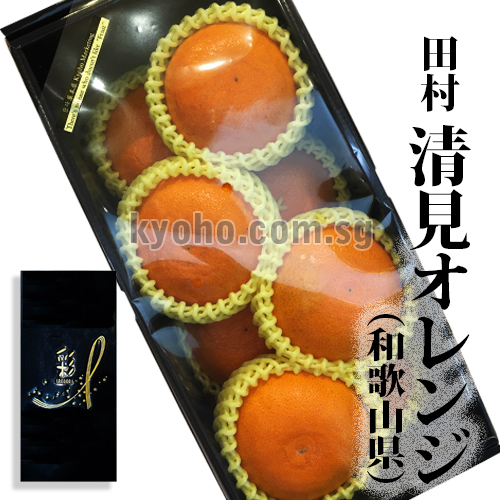 |
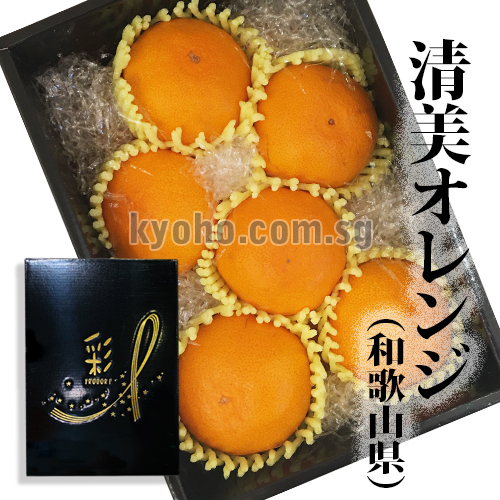 |
| GF/CTR-001: | GF/CTR-094: | GF/CTR-096: |
| KIYOMI TANGOR - MISAKI (PREMIUM GRADE / Sugar Level 11˚ up) Ehime Prefecture |
TAMURA KIYOMI ORANGE Wakayama Prefecture (8pcs) |
KIYOMI ORANGE Wakayama Prefecture |
 |
 |
 |
| GF/CTR-002: | GF/CTR-003: | GF/CTR-004: |
| HAUSE MIKAN KARATSU Saga Prefecture (approx 1kg) Sugar level 12°~ |
HOUSE MIKAN - ARIDA MIKAN (PREMIUM GRADE / Sugar Level 12˚ up) Wakayama Prefecture (approx 1kg / 10pcs) |
KARA MANDARIN (PREMIUM GRADE / Sugar Level 11˚ up) Ehime Prefecture |
 |
 |
 |
| GF/CTR-005: | GF/CTR-006: | GF/CTR-006-12p: |
| HOUSE MIKAN - GENSEN TAKUMI no AJI (PREMIUM GRADE / Sugar Level 13˚ up) Nagasaki Prefecture (approx 1.5kg /16pcs) |
HOUSE MIKAN Tokushima Prefecture (approx 1.2kg) Sugar level 11°~ |
HOUSE MIKAN Tokushima Prefecture (12pcs / approx 1.2kg) Sugar level 11°~ |
 |
 |
 |
| GF/CTR-007: | GF/CTR-008: | GF/CTR-037: |
| ARIDA no HOUSE MIKAN TAIYO no KIWAMI Wakayama Prefecture (16pcs / approx 1.3kg) |
HOUSE MIKAN - SANUKI BENI (PREMIUM GRADE) Kagawa Prefecture (21~25pcs / approx 3kg) |
GAMAGOURI HOUSE MIKAN Aichi prefecture (S size / 15pcs) |
 |
 |
 |
| GF/CTR-038: | GF/CTR-048: | GF/CTR-077: |
| ARIDA no HOUSE MIKAN Wakayama prefecture (S size / 12pcs / approx 1kg) |
HOUSE MIKAN TAMURA Wakayama Prefecture (12pcs / approx 1kg) |
ARIDA no HOUSE MIKAN Wakayama Prefecture (12pcs / approx 1kg) |
 |
||
| GF/CTR-089: |
||
| HOUSE MIKAN Kochi Prefecture (15pcs / approx 1.2kg) Sugar level 11°~ |
||
"Daimasaki" has a bright red colour and a rich sweetness.Since it was registered as a variety in 2006, it has continued to grow as one of the finest citrus fruits from Kagoshima Prefecture. |
||
 |
 |
 |
| GF/CTR-018-7P: | GF/CTR-018-8P: | GF/CTR-018-10P: |
| DAIMASAKI Kagoshima Prefecture (7pcs / approx 3kg) |
DAIMASAKI (AKA-SHU GRADE) Kagoshima Prefecture (8pcs / approx 3kg/box) |
DAIMASAKI (AKA-SHU GRADE) Kagoshima Prefecture (10pcs / approx 3kg/box) |
 |
 |
 |
| GF/CTR-018-12P: |
GF/CTR-025-6P: |
GF/CTR-025-6P: |
| DAIMASAKI (AKA-SHU GRADE) Kagoshima Prefecture (12pcs / approx 3kg/box) |
DAIMASAKI Kagoshima Prefecture (6pcs / approx 410g per pc) |
DAIMASAKI Kagoshima Prefecture (6pcs / approx 330g per pc) |
One of the most popular citrus fruits of spring.A cross between the Kiyomi orange and the Ponkan, this variety is characterised by its easy peeling and palatability. The name ‘Kijuku 301’ comes from the fact that the fruit is ripened on the tree for more than 301 days after flowering in May, which is longer than usual. Only those Dekopon that have passed the sugar and acid levels checks using light sensors and are shipped. The sugar content of normal Dekopon is 13 degrees, but this one is 15 degrees! The long maturation on the tree gives it a strong sweetness and a rich flavour and aroma. |
||
 |
 |
 |
| GF/CTR-063-8P: |
GF/CTR-063-10P: |
GF/CTR-063-12P: |
| KIJUKU 301 DEKOPON Wakayama Prefecture (8pcs / approx 3kg) |
KIJUKU 301 DEKOPON Wakayama Prefecture (10pcs / approx 3kg) |
KIJUKU 301 DEKOPON Wakayama Prefecture (12pcs / approx 3kg) |
 |
 |
 |
| GF/CTR-063-6PL: | GF/CTR-063-6PM: | GF/CTR-031: |
| KIJUKU 301 DEKOPON Wakayama Prefecture (6pcs / approx 3kg) |
KIJUKU 301 DEKOPON Wakayama Prefecture (6pcs / 3L size / approx 375g per pc) Suger level 15° |
DAIMASAKI PREMIUM DEKOPON (Premium Grade) Kagoshima prefecture (3L size / 15pcs / approx 330g/pc) |
A gem that comes out in the final stages of the season.Dekopon (Shiranui) are generally harvested between December and February, but instead of picking them then, they wait another month or two and ripen on the tree until just before shipping in March or April. Most regions harvest early because of the increased risk of disease, insect damage and weather, which reduces the percentage of correct products, but this is compensated for by the high level of technology developed over a long history of production. The fruit must have a sugar content of at least 13% during an inspection in early February, and must be harvested after growing on the tree until March. Only Dekopon that meet these criteria can call themselves “Tree-Ripened Dekopon". |
||
 |
||
| GF/CTR-075: |
||
| GAMAGORI KIJUKU DEKOPON (Tree-Ripened) Aichi Prefecture (3L size / 10pcs / approx 3.5kg) |
||
What is Chūban-kan...?Chūban-kan is the general term for citrus fruits that appear from the beginning of the year to May, taking over from Unshu-mikan (mandarin oranges). There are so many varieties with different appearances, seasons and origins that it is impossible to count them all, and many varieties continue to be developed, including 'Kiyomi', 'Setaka', 'Shiranui' and many others with a wide variety. |
||
 |
||
| GF/CTR-076: |
||
| YAMATORA no CHUBANKAN (SHIRANUI) Wakayama Prefecture (12pcs) |
||
Beni Madonna is a tangor* of tangerine and orange blood, a cross between the 'Nanko' and 'Amakusa' varieties*Tangor generally refers to a cross between a mandarin orange and an orange.This citrus variety was registered in 2005 and is a palm-sized fruit, slightly larger than a typical tangerine. The nickname 'Beni Madonna' is a registered trade mark of JA Zen-Noh Ehime, and cultivation is limited to Ehime Prefecture only, with the variety name Ehime Fruit Experiment No. 28. Only those that meet certain strict standards are shipped as 'Beni Madonna’. One of the main attractions of Beni Madonna is its new, melt-in-your-mouth texture, which is described as 'jelly-like'. Each piece of pulp is smooth and full of juice, as if it were a single piece of fruit. The thin skin inside is also extremely thin and does not affect the taste at all, creating an elegant texture. The lovely name is said to derive from 'Madonna', the heroine of Soseki Natsume's novel 'Botchan', which is set in Matsuyama City, Ehime Prefecture. |
||
 |
 |
 |
| GF/CTR-017-2L12: | GF/CTR-017-L15: | GF/CTR-017-f: |
| BENI MADONNA (Whte Box) Ehime Prefecture (2L size / 12pcs / approx 3kg/box) |
BENI MADONNA (Whte Box) Ehime Prefecture (L size / 15pcs / approx 3kg/box) |
BENI MADONNA (Black Box) Ehime Prefecture (2L size / 12pcs / approx 3kg/box) |
 |
 |
|
| GF/CTR-017-g: | GF/CTR-017-3L: | |
| BENI MADONNA (Black Box) Ehime Prefecture (L size / 15pcs / approx 3kg/box) |
BENI MADONNA Ehime Prefecture (approx 3kg) 糖度/Sugae Level: 13˚~ *Available: 4L/8pcs, 3L/10pcs, 2L/12pcs |
|
I want to eat more 'Beni Madonna’!The variety is the same as the high-end citrus Beni Madonna. It just slightly falls short of the standards for sugar content, acidity and appearance. But if you want to eat more Beni Madonna and it's not for gift-giving, then Aika is the one for you! |
||
 |
 |
|
| GF/CTR-019-a: |
GF/CTR-019-b: |
|
| AIKA (Same variety as BENI MADONNA) Ehime Prefecture (M size / 6pcs) |
AIKA (Same variety as BENI MADONNA) Ehime Prefecture (L size / 6pcs) |
|
Mishoukan, also known as Kawachi-bankan
|
||
 |
 |
|
| CTR-078: |
||
| MISHOUKAN Ehime Prefecture (4pcs) |
||
 |
 |
 |
| GF/CTR-078-6PL: | GF/CTR-078-6PM: | GF/CTR-078-3PM: |
| MISHOKAN Ehime Prefecture (6pcs / 500g per pc) Sugar level above 11°~ |
MISHOKAN Ehime Prefecture (6pcs / 360g per pc) Sugar level above 11°~ |
MISHOKAN Ehime Prefecture (3pcs / 360g per pc) Sugar level above 11°~ |
The white peel (albedo) and pulp together give the fruit a unique flavour not found in other citrus fruits.Hyuganatsu is thought to be a mutant species of yuzu, discovered in 1820 in the garden of Yasutaro Makata in Miyazaki. It has since become a speciality of Miyazaki Prefecture and is now grown in many parts of Japan, and is produced and shipped as 'Tosa Konatsu' and 'Konatsu Mikan' in Kochi Prefecture, as well as 'New Summer Orange' in Ehime and Shizuoka Prefectures.The pulp and juice are highly acidic and refreshing, but the white inner skin (albedo) between the outer skin and pulp has a slight sweetness, and eating this white skin (albedo) and pulp together gives it a unique flavour not found in other citrus fruits. Unlike normal mandarins, the peel is peeled thinly like an apple, cut into wedges with the fruit and eaten together with the white part and the fruit. |
||
 |
 |
 |
| GF/CTR-020-12P: | GF/CTR-021-9P: | GF/CTR-021-12P: |
| PRINCESS HYUGANATSU Miyazaki Prefecture (12pcs / approx 2.2kg) |
HYUGANATSU-CHAN Miyazaki Prefecture (9pcs / approx 2.5kg) |
HYUGANATSU (SEEDLESS) Miyazaki Prefecture (12pcs / approx 2.5kg) |
 |
 |
|
| CTR-021-13P: |
CTR-021-3P: |
|
| HYUGANATSU-CHAN Miyazaki Prefecture (13pcs / approx 2kg) |
HYUGANATSU-CHAN Miyazaki Prefecture (3pcs / approx 400g) |
|
Kara-mandarins "Mikyan's Nakajima News" - highest grade “匠(Takumi) and 極 (Kiwami)”.Kara-mandarins are an extremely late ripening mandarin that ripens later than other Unshu mandarins and is harvested after enduring a cold winter. After a long ripening period on the tree, the mandarins have a concentrated flavour, with a good acidity and a strong sweetness. It is a very rare variety that flowers next year at harvest time, and is a juicy spring tangerine with no seeds, easy to peel and with a sweet, rich flavour. Kala-mandarin was bred at the University of California in the USA from a cross between Unshu Mandarin and King Mandarin, and was introduced to Japan in 1955 after being released in 1935.Initially, it was shunned because of its difficulty in cultivation and management, and its strong acidity, but when a variety survey was conducted after seeing chickadees flocking to neglected Kara-mandarins, production increased due to its excellent taste, and the quality of Kara-mandarins was re-evaluated. The highest grade [ 匠 (Takumi) and 極 (Kiwami)] kara-mandarins, cultivated by the masters of Nakajima, a famous mandarin producing area, are delivered in a very cute "Mikyan" individually wrapped package. |
||
 |
 |
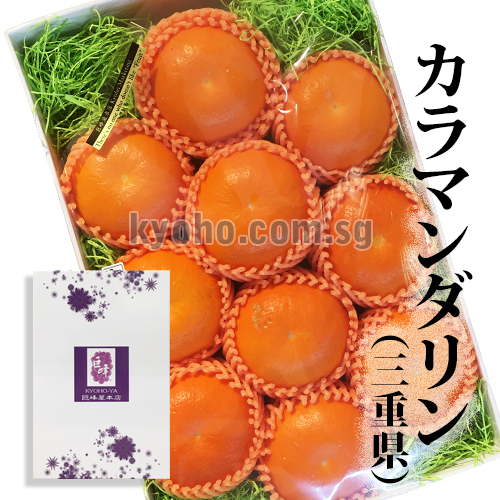 |
| GF/CTR-036: |
GF/CTR-064: |
GF/CTR-093: |
| KARA MANDARIN - MIKYAN NO NAKAJIMA DAYORI Ehime Prefecture (12pcs / approx 1.2kg) |
KARA-MANDARIN Wakayama Prefecture (M size / 12pcs / approx 1.5kg) |
KARA-MANDARIN Mie Prefecture (10pcs / approx 1.2kg) |
What is MATOUHYOU MIKAN?“Matouhyou” is Arida from Wakayama Prefecture. Genuine-oriented “discerning” making it is a mandarin orange that is not too sweet and not too sour and has a mellow flavour. As the name “Mellow mandarin orange” is also known, the target soldier mandarin orange has a good balance of sweetness and acidity, and is characterised by a mellow taste. This is because we use all - “organic fertilizer” that uses high-quality fishmeal to create a mellow taste that is environmentally friendly, in search of a handmade taste. Never take the powder attached to the target Matouhyou orange. It is a large powder to maintain the flavourful oranges. This powder is a mixture of “calcium” and “sulfur”, which enhances subtle water control and storability. 和歌山县产的“有田”田ロ式士兵橙子化妆盒正宗的“挑别”制作这是一种不太甜也不太酸,味道醇厚的橘子。 橘子的特点是味道因为它也被称为“ Meloya Kamikan”醇厚,甜度和酸度平衡良好。 这是因为我们使用全“有机肥”环保口感,寻找手工制作的味道。 ,使用优质鱼粉打造醇厚的千万不要把附着在目标士兵橘子上的粉末拿走。 它是一种大粉,可以保持橙子的美味。 这种粉末是“钙”和“硫”的混合物,可增强微妙的水分控制和可储存性。 请放心,它取自大自然,放入口中无害。 拥有黑潮得天独厚的气候的 |
||
 |
 |
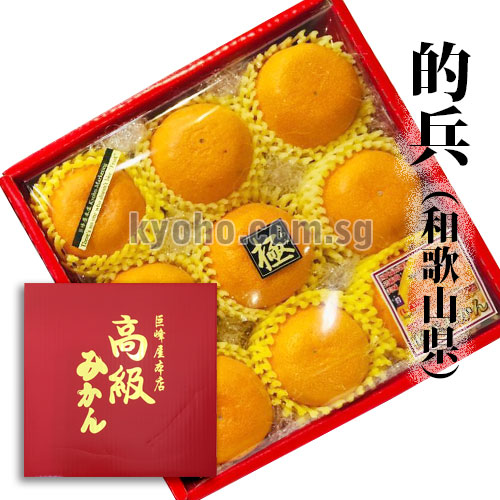 |
| GF/CTR-015-a: |
GF/CTR-015-b: |
GF/CTR-015-c: |
| MATOHYO MIKAN (TOP PREMIUM GRADE - AKA SHU) Wakayama Prefecture (2L size/ 9pcs / approx 1.5kg) |
MATOHYO MIKAN (TOP PREMIUM GRADE - AKA SHU) Wakayama Prefecture (L size/ 10pcs / approx 1.5kg) |
MATOHYO MIKAN (TOP PREMIUM GRADE - AKA SHU) Wakayama Prefecture (L size/ 18pcs) |
 |
 |
 |
| GF/CTR-026-a: |
GF/CTR-026-b: |
GF/CTR-026-c: |
| MATOHYO MIKAN (TOP PREMIUM GRADE - AKA SHU) Wakayama Prefecture (L size/ 35pcs / approx 5kg) |
MATOHYO MIKAN (TOP PREMIUM GRADE - AKA SHU) Wakayama Prefecture (M size/ 45pcs / approx 5kg) |
MATOHYO MIKAN (TOP PREMIUM GRADE - AKA SHU) Wakayama Prefecture (S size/ 55pcs / approx 5kg) |
What is ARIDA NO SHINDOU MIKAN?At the westernmost end of Arida, the peninsula that just out into the Kii Suidou (Kii Channel), the peninsula is about to sink into the sea, and the small settlement that was opened there is the “Shindo district”. The mountain here is made of dark green metamorphic rock called chlorite, which is [the viscous soil where the rock is weathered], [the whole garden is abundantly sunshine facing south], and [is carried by the sea breeze Minerals], nurture dark-colored, deep-tasting oranges.在有田的最西端,伸入纪伊水道的半岛,半岛即将沉入大海,在那里开辟的小聚落就是“新道区”。 这里的山是由一种叫做绿泥石的深绿色变质岩构成,是【岩石风化的粘性土壤】,【全园朝南阳光充沛】,【被海风吹来】矿物质的滋养颜色深,味道深的橙子。 |
||
 |
 |
 |
| GF/CTR-024: |
GF/CTR-027: |
GF/CTR-035: |
| ARIDA SHINDO MIKAN (PREMIUM GRADE - AKA SHU) Wakayama Prefecture (2L size / 9pcs / approx 1.5kg) |
ARIDA SHINDO MIKAN (PREMIUM GRADE - AKA SHU) Wakayama Prefecture (L size / 18pcs) |
SHINDO MIKAN (PREMIUM GRADE) Wakayama prefecture (2L size / 16pcs) |
 |
 |
|
| GF/CTR-069: | CTR-007: | |
| ARIDA SHINDO MIKAN (PREMIUM GRADE - AKA SHU) Wakayama Prefecture (L/M size / approx 3kg) |
ARIDA SHINDO MIKAN (PREMIUM GRADE - AKA SHU) Wakayama Prefecture (M size / 9pcs) |
|
Tamura Mikan, the best brand of Arida mandarin oranges from Wakayama, the largest producer of mandarin oranges in JapanThe Arida region of Wakayama Prefecture has a history of more than 400 years of tangerine cultivation, which began in 1913.The mandarin oranges from Tamura in the town of Yuasa are called 'Tamura Mikan' and are a brand within the Arida mikan category. |
||
 |
 |
 |
| GF/CTR-010: | GF/CTR-046: | GF/CTR-049-L: |
| TAMURA MIKAN (FARM DIRECT) Wakayama Prefecture (L size / 20pcs) |
TAMURA MIKAN (PREMIUM GRADE - AKASHU / FARM DIRECT) Wakayama prefecture (L size / 40pcs / approx 5kg) |
TAMURA MIKAN (PREMIUM GRADE - AKASHU / FARM DIRECT) Wakayama prefecture (L size / 26pcs / approx 3kg) |
 |
 |
 |
| GF/CTR-066-L: |
GF/CTR-066-M: |
GF/CTR-066: |
| TAMURA MIKAN Wakayama Prefecture (L size / 18pcs) |
TAMURA MIKAN Wakayama Prefecture (M size / 18pcs) |
TAMURA MIKAN Wakayama Prefecture (M size / 12pcs) |
For 100 years, three suns* have nurtured "much tastier" Mikan*Ehime Prefecture is said to have "three suns ". The first refers to the sun shining in the tropical sky, the second to the sun reflecting off the sea, and the third to the sun shining off and reflecting off the stone walls built on the slopes. Blessed with these 'three suns', citrus fruits in Ehime grow to be sweet and juicy.Specialising in Unshu mikan (mandarins), the farmers take the time and effort to cultivate them without labour-saving work, using sensors to measure sugar content and acidity, cameras to measure colour, flaws, shape and size, and rot sensors to thoroughly remove any damaged fruit. The fruits are commercialised with names such as ‘豪琉頭千両 (Gold Senryo)’, ‘日の丸千両 (Hinomaru Senryo)’, ‘百年柑橘 (Hyakunen Kankitsu)’ and ‘ガキ大将 (Gaki Daisho)’, according to their rank in terms of colour and shape. |
||
 |
 |
 |
| GF/CTR-016-a: |
GF/CTR-016-b: |
GF/CTR-016-c: |
| HINOMARU MIKAN (LUXURY GRADE) Ehime Prefecture (L size / 38pcs / approx 3kg/box) |
HINOMARU MIKAN (LUXURY GRADE) Ehime Prefecture (M size / 48pcs / approx 3kg/box) |
HINOMARU MIKAN (LUXURY GRADE) Ehime Prefecture (S size / 48pcs / approx 3kg/box) |
 |
 |
|
| GF/CTR-016-d: | GF/CTR-016-e: | |
| HINOMARU MIKAN (PREMIUM GRADE) Ehime Prefecture (L size / 12pcs) |
HINOMARU MIKAN (PREMIUM GRADE) Ehime Prefecture (M size / 16pcs) |
|
For many years, the tastiest mandarin in the Kyoto market has been considered to be Shindo Mikan's 'Genjiro’.Shindo Mikan is one of the best quality mandarins in Wakayama, a famous mandarin producing area in Japan. Among the many producers of Shindo Mikan, this is the Mikan of "GENJIRO", a highly respected master. |
||
 |
 |
 |
| GF/CTR-028-a: |
GF/CTR-028-b: |
|
| ARIDA SHINDO MIKAN (LUXURY GRADE) Wakayama Prefecture (L size / 12pcs) |
ARIDA SHINDO MIKAN (LUXURY GRADE) Wakayama Prefecture (M size / 12pcs) |
|
 |
 |
 |
| GF/CTR-009: | GF/CTR-012: | GF/CTR-041: |
| SAIKAI - AJIKKO MIKAN Nagasaki Prefecture (20pcs) |
SAIKAI - AJIKKO MIKAN Nagasaki Prefecture (M size / 18pcs) |
AJIKKO MIKAN (PREMIUM - SHU GRADE) Nagasaki Prefecture (S size / 60pcs / approx 5kg) |
 |
 |
 |
| GF/CTR-055-M12P: | GF/CTR-055-M24P: | GF/CTR-055-L20P: |
| SAIKAI AJIKKO MIKAN (HOUSE GROWN) Nagasaki Prefecture (M size / 12pcs / approx 1.2kg) |
SAIKAI AJIKKO MIKAN (HOUSE GROWN) Nagasaki Prefecture (Msize / 24pcs / approx 4kg) |
AJIKKO MIKAN (HOUSE GROWN) Nagasaki Prefecture (Lsize / 20pcs / approx 4kg) |
 |
 |
|
| GF/CTR-055-18P: |
GF/CTR-067: | |
| SAIKAI AJIKKO MIKAN Nagasaki Prefecture (18pcs) |
SAIKAI - AJIMARU Nagasaki Prefecture (M size / 12pcs) |
|
Yamakawa Mikan, one of Japan's top brands of mandarin oranges with outstanding taste, which can be tasted from mid-OctoberThe town of Yamakawa, also known as 'Mikan Town', and the city of Miyama in Fukuoka Prefecture are famous for their sweet and tasty 'Yamakawa Mikan'. The variety is called 'Kitaharawase' and was registered in 2009.The JA Minami Chikugo Citrus Club checks the quality carefully and classifies the oranges into three brands: Marutoku (Hakata Mild, Honey Mikan), Mild (Mild 130) and Regular. The three brands are classified into three categories, with standard values for sugar content and acidity, etc. The 'Marutoku' and 'Mild' ranks are required to be cultivated under mulch. Under these thorough controls, very high-quality, tasty mandarins have been produced with a high sugar content of more than 12° and a production content of less than 1%, thanks to moderate acidity. |
||
 |
 |
 |
| GF/CTR-065-a: |
GF/CTR-065-b: |
GF/CTR-065-c: |
| YAMAKAWA MIKAN Fukuoka Prefecture (approx 5kg/box) |
YAMAKAWA MIKAN Fukuoka Prefecture (L size / 12pcs) |
YAMAKAWA MIKAN Fukuoka Prefecture (M size / 12pcs) |
Limited edition mikan from a particular farm known to those in the knowWakayama Prefecture is known as a major citrus growing region, with Arida Mikan, Tamura Mikan and Shindo Mikan being particularly famous.Itomago Farm is said to be one of the pioneers of citrus cultivation in Wakayama Prefecture. |
||
 |
 |
 |
| GF/CTR-013: |
GF/CTR-014: |
GF/CTR-068: |
| ARIDA NO ITOMAGO MIKAN (Itomago Farm /Mandarin) Wakayama prefecture (L size / 18pcs) |
ARIDA NO MAGO MIKAN (Itomago Farm /Mandarin) Wakayama prefecture (approx 2kg) |
MAGO-MIKAN Wakayama Prefecture (15pcs/ approx 1.5kg) |
 |
||
| GF/CTR-070: | ||
| MAGO-MIKAN Wakayama Prefecture (approx 5kg) *Available size: L/M/S |
||
Yutoku Mikan is the most popular top-end product of Saga Prefecture's 佐賀美人(Saga Bijin) mandarins.“Yutoku" is named after Yutoku Inari Shrine in Kashima, which is famous as one of Japan's three most famous Inari shrines and a god of business prosperity.Only mandarins that have been carefully selected according to even stricter selection standards for variety, cultivation method and fruit selection criteria are shipped as 'Yutoku Mikan’. The mandarins carefully selected from among the Saga Bijin have a sugar content of 13 degrees or more and a good acidity. That is why they are so few in number (only about 1% of all occurrences) and are a rare product, making them ideal as gifts for loved ones. |
||
 |
||
| GF/CTR-072: |
||
| SHOBAI HANJO YUUTOKU MIKAN (SPECIAL SELECTED) Saga Prefecture (L size / 35pcs / approx 5kg) *Available: 10 boxes |
||
 |
 |
 |
| GF/CTR-011: | GF/CTR-029: | GF/CTR-040: |
| KURADASHI MIKAN Wakayama Prefecture (M size / 18pcs) |
OHARABENI WASE-MIKAN Kagawa Prefecture (M size / 30pcs / approx 100g/pc) |
DEJIMA NO HANA (TOP QUALITY PREMIUM - SHU GRADE) Nagasaki Prefecture (S size / 60pcs / approx 5kg) |
 |
 |
 |
| GF/CTR-043: |
GF/CTR-045: |
GF/CTR-050: |
| HANA TACHIBANA Fukuoka Prefecture (M size / 50pcs / approx 5kg) |
HAKATA MILD MIKAN (PREMIUM GRADE - AO-SHU) Ehime Prefecture (L size / 40pcs / approx 5kg) |
HIME-MIZUKI Ehime Prefecture (L size / 40pcs / approx 5kg) |
 |
 |
 |
| GF/CTR-052: |
GF/CTR-079: |
GF/CTR-085-12P: |
| SAISHOKU KAJITSU NO MIKAN Wakayama Prefecture (12pcs / approx 1.2kg) |
KITAHARA WASE MIKAN Fukuoka Prefecture |
NIJYUMARU MIKAN Saga Prefecture (12pcs / approx 3kg) |
 |
||
| GF/CTR-085-6P: | ||
| NIJYUMARU MIKAN Saga Prefecture (6pcs / approx 300g+ per pc) |
 |
 |
 |
| GF/CTR-056: |
GF/CTR-057: |
GF/CTR-059: |
| TAROKKO (BLOOD ORANGE) Ehime prefecture (L size / 8pcs) |
TAROKKO Ehime prefecture (L size / 4pcs) |
TAROKKO (BLOOD ORANGE) Oita prefecture (11pcs / approx 2.5kg) |
 |
 |
 |
| GF/CTR-060: |
GF/CTR-084: |
GF/CTR-084-9P: |
| TAROKKO (BLOOD ORANGE) (AO-SHU GRADE) Ehime prefecture (4L size / 8pcs approx 260g/pc) |
MaAna no TAROKKO BLOOD ORANGE Ehime Prefecture (S size / approx 2kg) |
MaAna no TAROKKO BLOOD ORANGE Ehime Prefecture (9pcs) |
 |
 |
 |
| GF/CTR-030-8P: | GF/CTR-030-10P: | GF/CTR-030-12P: |
| SETOKA Saga Prefecture (4L size / 8pcs / approx 3kg) |
SETOKA Saga Prefecture (3L size / 10pcs / approx 3kg) |
SETOKA Saga Prefecture (2L size / 12pcs / approx 3kg) |
 |
 |
 |
| GF/CTR-034: | GF/CTR-042-8P: | GF/CTR-042-10P: |
| SETOKA Saga Prefecture (2L size / 12pcs / approx 3kg) |
SETOKA Ehime Prefecture (4L size / 8pcs / approx 3kg) |
SETOKA Ehime Prefecture (3L size / 10pcs / approx 3kg) |
 |
 |
 |
| GF/CTR-042-c: |
GF/CTR-042-d: |
GF/CTR-042-e: |
| SETOKA Ehime Prefecture (6pcs) |
SETOKA Ehime Prefecture (8pcs) |
SETOKA Ehime Prefecture (8pcs) |
 |
 |
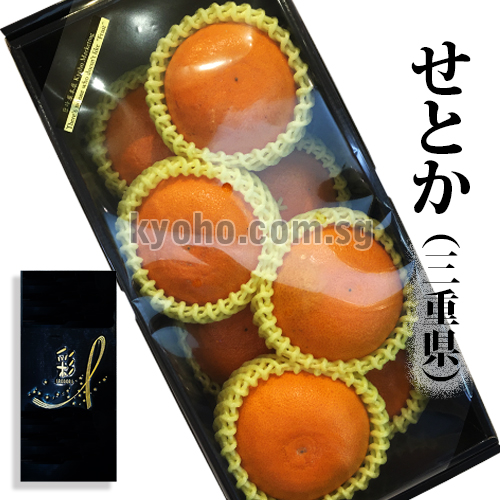 |
| GF/CTR-042-15P: | GF/CTR-042-f: | GF/CTR-042-g: |
| SETOKA Ehime Prefecture (L size / 15pcs / approx 3kg) |
SETOKA Premium Grade - AKA-SHU Nagasaki Prefecture (8pcs) |
SETOKA Mie Prefecture (8pcs) |
 |
 |
 |
| GF/CTR-042-h: |
GF/CTR-054-12P: | GF/CTR-061-6P: |
| SETOKA MiePrefecture (8pcs) |
SETOKA Ehime Prefecture (2L size / 12pcs / approx 3kg) |
NANKI SETOKA Mie Prefecture (6pcs / approx 350g+ per pc) |
 |
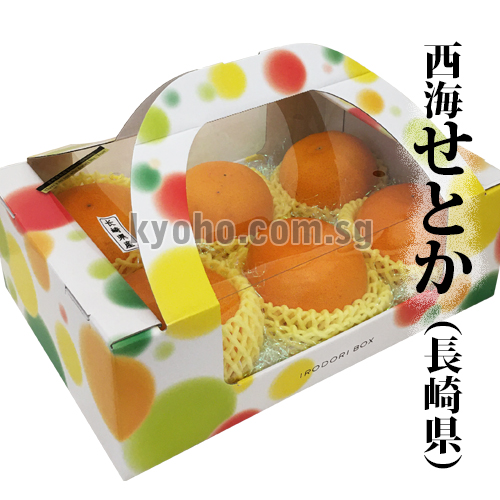 |
 |
| GF/CTR-087: | GF/CTR-087-6P: | GF/CTR-088: |
| SAIKAI SETOKA Nagasaki Prefecture (6pcs / approx 375g+ per pc) Suger level above 12°~ |
SAIKAI SETOKA Nagasaki Prefecture (6pcs) Sugar level avobe 12° |
ARIDA SETOKA Wakayama Prefecture (3L size / 10pcs) |
The ultimate tangor born from the best citrus fruits of the past.The ultimate next-generation citrus, created by crossing ‘Kiyomi’ and ‘Trovita oranges’ to produce ‘Nishinoka’, and then ‘Ponkan’ to produce Ehime Prefecture's ultimate next-generation citrus after many years of hard work and effort.It is characterised by its high sugar content and low citric acid content (around 1.1%), which gives it a strong sweetness, and its sweetness is felt as a jelly-like pulp rather than a dripping juiciness. |
||
 |
 |
 |
| GF/CTR-032-8P: |
GF/CTR-032-12P: |
GF/CTR-032-15P: |
| KANPEI (TOP PREMIUM CITRUS) Ehime Prefecture (4L size / 8pcs / approx 3kg) |
KANPEI (TOP PREMIUM CITRUS) Ehime Prefecture (2L size / 12pcs / approx 3kg) |
KANPEI (TOP PREMIUM CITRUS) Ehime Prefecture (L size / 15pcs / approx 3kg) |
 |
 |
|
| GF/CTR-033-6P: | GF/CTR-033-8P: | |
| KANPEI Ehime Prefecture (6pcs / approx 250g/pc) |
KANPEI Ehime Prefecture (8pcs / approx 250g/pc) |
|
 |
 |
|
| GF/CTR-082-8P: | GF/CTR-082-10P: | |
| QUEEN SPLASH (HIGHEST QUALITY OF KANPEI) Ehime Prefecture (4L size / 8pcs / approx 3kg) |
QUEEN SPLASH (HIGHEST QUALITY OF KANPEI) Ehime Prefecture (3L size / 10pcs / approx 3kg) |
|
The season is short! Named so because once you have tasted it, you will never forget it and want to encore it.Encore is said to be a variety bred by Dr Frost and his colleagues at the University of California, USA, by crossing King (Tangor) and Mediterranean mandarins, and was introduced in 1965. It is said to have been introduced to Japan in 1969, but its cultivation area is still small and it is only sold in a few speciality shops such as department stores as a luxury citrus due to its rarity and rich sweetness. Harvesting is concentrated in March and the best season for eating is only available for a short period from March to April. |
||
 |
 |
 |
| GF/CTR-044-9P: | GF/CTR-044-4L: | GF/CTR-044-2L: |
| ENCORE ORANGE Ehime Prefecture (9pcs / approx 2.2kg) |
ENCORE ORANGE Ehime Prefecture (4L size / 18pcs / approx 4.5kg) |
ENCORE ORANGE Ehime Prefecture (2L size / 27pcs / approx 4.5kg) |
Seminole oranges were born in the United States and grown in Arida, Kishu, the home of mandarins, where they enjoy the benefits of the Kuroshio sea breezes and the sun.The Seminole is a hybrid of the Duncan Grapefruit and Dancy Tangerines. It was introduced to Japan in 1955. It has a rich flavour with a strong sweetness and acidity. The pulp is soft and the juice is very rich. The jōno-membrane (thin skin) is thin and juicy, so a smile-cut is recommended when eating it. |
||
 |
||
| GF/CTR-074: | ||
| SEMINOLE ORANGE Wakayama Prefecture (10pcs / approx 200g per pc) |
||
Buntan is native to the Malay Peninsula and Indochina.It is said to have been introduced to Japan at the end of the Muromachi period (1336-1573). Most of the cultivated varieties today are grown from scions introduced from Taiwan and China after the Meiji era (1868-1912), and then bred and hybridised. It is characterised by its high juice content and soft pulp. It has a high sugar content and a refreshing acidity, making it a very palatable Buntan. It is said to be a crossbreed between the ‘Banoukan’ and ‘Tosa Buntan’, and was born in Kochi Prefecture and named in 1958. |
||
 |
 |
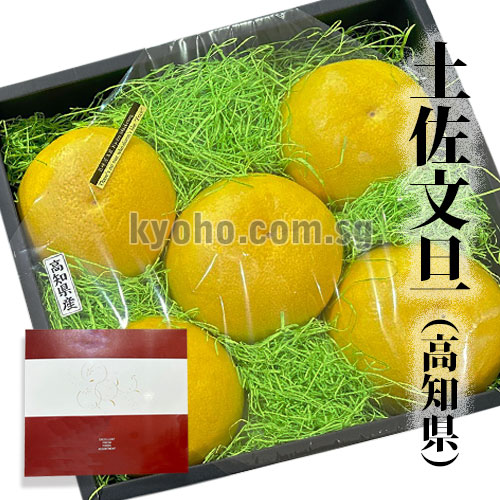 |
| GF/CTR-039: |
GF/CTR-073-a: |
GF/CTR-073-b: |
| SUISHO BUNTAN Aichi Prefecture (7pcs / approx 2kg) |
TOSA-BUNTAN Kouchi Prefecture (2pcs / approx 700g+/pc) |
TOSA-BUNTAN Kouchi Prefecture (5pcs / approx 700g+/pc) |
The world's largest citrus with a sugar content of around 11 degrees and a mild acidity of about 1.3%.In 1920, the high quality fruit variety Banpeiyu was imported to Taiwan from its native Malay Peninsula by Yaichi Shimada, a botanist from Kumamoto Prefecture who was working for the Taiwan Governor-General's Office at the time. Fifteen years later, in 1935, through the kindness of Mr Shimada, a trial production was conducted at the Kumamoto Prefectural Fruit Experiment Station, and it was found to be well suited to the climate of Kumamoto, especially the Yatsushiro region. The origin of the name comes from the fact that in Taiwan, oranges with white flesh are called 白柚 peiyu (white citron), and because they ripened 晩 (晩生) late, they were called 晩白柚 (Banpeiyu). |
||
 |
 |
 |
| GF/CTR-051: | ||
| BANPEIYU Kumamoto Prefecture (L, 2L size / approx 1.6kg, 2kg) |
(1) Cut the upper skin with a knife. (1) 用刀切下上部果皮。 |
(2) Cut the skin lengthwise into eight equal pieces, deep enough not to damage the contents. (2) 将外皮纵向切成八等份, 切口要足够深,以免损坏内含物。 |
 |
||
| GF/CTR-080: | ||
| KIJUKU PONKAN Wakayama Prefecture (24pcs / approx 5kg) |
||
|
|
||
 |
 |
 |
| GF/CTR-083-9P: | GF/CTR-086-6P: | GF/CTR-091: |
| HAMASAKI Premium Orange Saga Prefecture (9pcs / approx 250g+ per pc) |
HARUKA ORANGE Hiroshima Prefecture (6pcs / approx 160g+ per pc) Suger level 13° |
MIHAYA ORANGE Kagoshima Prefecture (M size / 28pcs / approx 2kg) 糖度/Sugar Level: 12˚~ |
 |
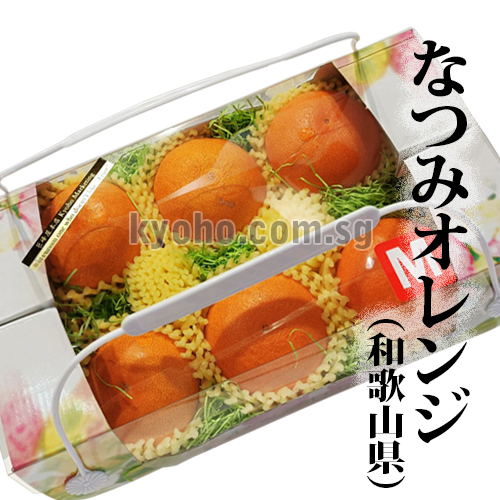 |
|
| GF/CTR-092: | GF/CTR-095: | |
| JELLY ORANGE SUN CELEB OitaPrefecture (approx 3kg) 糖度/Sugar Level: 12˚~ *Available size ; 9/10/12/14pcs |
NATSUMI ORANGE WakayamaPrefecture (6pcs) |
その他 / |
||
樫山農園 / KASHIYAMA FARM from Tokushima Pref. |
||
High sugar content ‘SANGOJU (Coral Tree Tomato)’ aiming to be the best in the world.The Sangoju is a brand of the Kashiyama Estate in Tokushima Prefecture, with a sugar content of over 8 degrees. The high selection standards and consistent taste are delivered directly from the farm.The tomatoes are cultivated using Kashiyama Farm's unique solution cultivation method, where the optimum fertiliser content is precisely controlled by computer and the water used is passed through a special water purifier, resulting in a high sugar content and a rich flavour with little cloying taste. You can choose your favourite size (total weight approx. 1 kg) Size S (24 pcs)---approx. 41 g per ball/ 43 mm in diameter M size (20 pcs)—approx. 50 g per ball/50 mm in diameter L size (18 pcs)—approx. 55 g/55 mm in diameter |
||
 |
 |
 |
| GF/OTR-001: | OTR-007: | |
| SANGOJU TOMATO (FARM DIRECT) Tokushima Prefecture (approx 1kg) *Available size: M Suger level above 10° |
FUSADORI TOMATO - URESHINO (BUNCH MINI TOMATO) Mie Prefecture (approx 220g) Suger level above 10°~ |
|
 |
 |
 |
| GF/OTR-051: | GF/OTR-052: | GF/OTR-056: |
| NOUSHUKU TOMATO (for SALAD use) Tokushima Prefecture (approx 1kg) |
FRUIT TOMATO SUZUKA (for SALAD use) Tokushima Prefecture (approx 1kg) |
HIGH SUGAR CONTENT TOMATO SUZUKA Hokkaido (approx 900g) Sugar level 10°~ |
マンゴー / MANGO |
||
Fully ripe mangoes fall off by themselves. This is the signal that they are fully ripe!The characteristic feature of Miyazaki fully ripe mangoes is that they are covered with a net and harvested when they are fully ripe and have naturally fallen into the net. The variety is 'Irwin’. It was first introduced to Miyazaki in 1984 by Shoichi Tate, then head of the fruit tree section of JA Saito, who was instructing farmers on cultivation and was impressed by the mangoes he encountered on a visit to Okinawa. Mangoes with the brand name 'Taiyo no Tamago' are marketed as 'Taiyo no Tamago', the highest grade of mango, if they meet the following criteria: sugar content of 15 degrees or more, a fruit weighing 350g or more and more than half of the fruit is bright red on the outside. |
||
 |
 |
 |
| GF/OTR-020-5L: |
GF/OTR-012-4L: |
GF/OTR-012-3L: |
| TAIYO NO TAMAGO (TOP PREMIUM) Miyazaki Prefecture (5L size / approx 900g/pc) |
TAIYO NO TAMAGO (TOP PREMIUM) Miyazaki Prefecture (4L size / 2pcs / approx 1.5kg) |
TAIYO NO TAMAGO (TOP PREMIUM) Miyazaki Prefecture (3L size / 2pcs / approx 1.3kg) |
 |
 |
|
| GF/OTR-014: |
||
| TAIYO NO TAMAGO (TOP PREMIUM) Miyazaki Prefecture (2L size / 3pcs / approx 1.5kg) |
||
 |
 |
 |
| GF/OTR-015-5L: |
GF/OTR-015-4L: | GF/OTR-015-3L: |
| KANJUKU MANGO (PREMIUM GRADE AKA-SHU) Miyazaki Prefecture (5L size / approx 900g) |
KANJUKU MANGO (PREMIUM GRADE AKA-SHU) Miyazaki Prefecture (4L size / approx 650g) |
KANJUKU MANGO (PREMIUM GRADE AKA-SHU) Miyazaki Prefecture (3L size / approx 480g) |
 |
 |
 |
| GF/OTR-033-4L: | GF/OTR-033-3L: | GF/OTR-033-2L: |
| KANJUKU MANGO (PREMIUM GRADE AKA-SHU) Miyazaki Prefecture (4L size / approx 650g) |
KANJUKU MANGO (PREMIUM GRADE AKA-SHU) Miyazaki Prefecture (3L size / approx 450g) |
KANJUKU MANGO (PREMIUM GRADE AKA-SHU) Miyazaki Prefecture (2L size / approx 380g+) |
 |
 |
|
| GF/OTR-033-M2P: |
GF/OTR-055: |
|
| KANJUKU MANGO (PREMIUM GRADE AKA-SHU) Miyazaki Prefecture (M size / 2pcs approx 600g) |
MINI MANGO (A GRADE) Miyazaki Prefecture (M size / 2pcs / approx 500g) |
|
Anti-ageing with passion fruit, which has high beauty benefits!It is rich in β-carotene, with 1100 µg per 100 g, which is one of the highest levels among fruits. β-carotene is converted into vitamin A in the body and is expected to help maintain healthy skin and mucous membranes, as well as boosting immunity. Passion fruit has been growing wild in its native South America for a long time, but it was not until the 17th century that it spread around the world. It was around this time that the name 'passion' was coined, and it is said that around 1610 a Spanish missionary saw the flower while travelling in South America and named it 'passion flower’. In Japan, it was introduced in the Meiji era (1868-1912) and is mainly grown in subtropical regions such as Okinawa Prefecture and the Amami Islands in Kagoshima Prefecture. |
||
 |
 |
 |
| GF/OTR-017-a: |
GF/OTR-017-b: |
GF/OTR-017-c: |
| PASSION FRUITS Okinawa Prefecture (8~9pcs / approx 1kg) |
PASSION FRUITS Okinawa Prefecture (12pcs / approx 1kg) |
PASSION FRUITS Okinawa Prefecture (M size / 11pcs / approx 1kg) |
 |
 |
 |
| GF/OTR-017-11P: |
GF/OTR-017-13P: | |
| PASSION FRUITS Okinawa Prefecture (11pcs / approx 1kg) |
PASSION FRUITS Okinawa Prefecture (13pcs / approx 1kg) |
|
A high-sugar pineapple with low acidity that can be torn into pieces and eaten by hand!The official name of this variety is the Bogor pineapple, which originates from Taiwan, but it is nicknamed the Snack Pine because it is easy to tear off and eat like a snack (even the core is tasty). Weighing between 700g~1kg, it is smaller than most pineapples and is characterised by the large gaps in its flesh. In terms of flavour, the pineapple is less acidic and has a stronger aroma. The sweetness is concentrated, so it is also recommended for people who have difficulty with sourness or a burning sensation on the tongue when eating regular pineapples. |
||
 |
 |
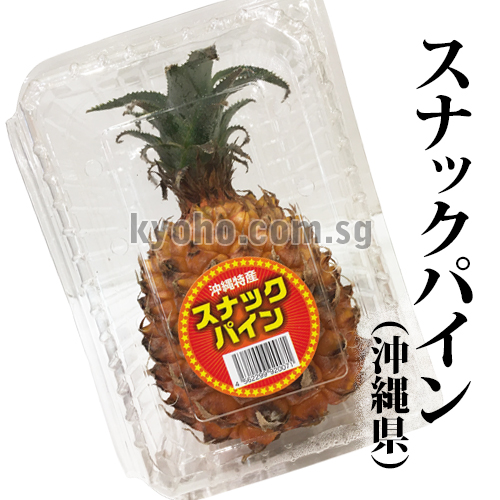 |
| GF/OTR-022: |
GF/OTR-032: |
GF/OTR-050: |
| PEACH PINE (BOGOR PINEAPPLE) Okinawa Prefecture (approx 650g) |
CHURA PINE (BOGOR PINEAPPLE) Okinawa Prefecture (approx 750g) |
SNACK PINE (BOGOR PINEAPPLE) Okinawa Prefecture (approx 500g) |
 |
 |
 |
| OTR-010: |
OTR-011: | |
| SNACK PINE (HAWAII PINEAPPLE) Okinawa Prefecture (approx 500g) |
SNACK PINE (BOGOR PINEAPPLE) Okinawa Prefecture (approx 500g) |
|
さくらんぼ / SAKURANBO (Cherry) |
||
 |
 |
 |
| GF/OTR-002-L: | GF/OTR-007-L: | GF/OTR-007-2L: |
| SHINSHU SAKURANBO - SATO NISHIKI Nagano Prefecture (L size / approx 300g) |
KIWAMI SAKURANBO - SATO NISHIKI (WOODEN BOX) Kochi Prefecture (L size / 48pcs / approx 300g) |
KIWAMI SAKURANBO - SATO NISHIKI (WOODEN BOX) Kochi Prefecture (2L size / 42pcs / approx 300g) |
 |
 |
 |
| GF/OTR-009-L: | GF/OTR-009-2L: | GF/OTR-010: |
| YAMAGATA NO SAKURANBO - SATO NISHIKI Yamagata Prefecture (L size / approx 300g) |
YAMAGATA NO SAKURANBO - SATO NISHIKI Yamagata Prefecture (2L size / approx 300g) |
SATO-NISHIKI Nagano Prefecture (2L size / approx 300g) |
 |
 |
 |
| GF/OTR-018: | GF/OTR-019: | GF/OTR-023: |
| BENI-SHUHOU (PREMIUM GRADE) Yamagata Prefecture (2L size/ approx 300g) |
SATOU-NISHIKI (PREMIUM GRADE) Yamagata Prefecture (L size/ approx 300g) |
SATOU-NISHIKI (CHOCOLATE GIFT BOX) Yamagata Prefecture (L size / approx 280g) |
 |
 |
 |
| GF/OTR-024: | GF/OTR-025: | GF/OTR-026: |
| BENI-SHUHOU & GASSAN-NISHIKI (CHOCOLATE GIFT BOX) Nagano Prefecture (3L size / approx 150g) |
BENI-SHUHOU (CHOCOLATE GIFT BOX) Nagano Prefecture (3L size/ approx 150g) |
YAMAGATA NO SAKURANBO - SATO NISHIKI (TOKUSHU GRADE) Yamagata Prefecture (approx 300g) |
 |
 |
 |
| GF/OTR-031-L: | GF/OTR-031-2L: | GF/OTR-034-2L: |
| SATO-NISHIKI (PREMIUM TOKUSHU GRADE) Yamagata Prefecture (L size / 48pcs approx 300g) |
SATO-NISHIKI (PREMIUM TOKUSHU GRADE) Yamagata Prefecture (2L size / 40pcs approx 300g) |
HIGASHINE SAKURANBO (SATO NISHIKI) Yamagata Prefecture (2L size) |
 |
 |
 |
| GF/OTR-034-L: | GF/OTR-035: | GF/OTR-045-L: |
| HIGASHINE SAKURANBO (SATONISHIKI) Yamagata Prefecture (L size) |
BENI SHUHOU Yamagata Prefecture (2L size) |
SATO NISHIKI Yamagata Prefecture (L size / approx 300g) |
 |
 |
 |
| GF/OTR-045-2L: | GF/OTR-045-3L: | GF/OTR-047-2L: |
| SATO NISHIKI Yamagata Prefecture (2 size / approx 300g) |
SATO NISHIKI Yamagata Prefecture (3L size / approx 300g) |
SATO-NISHIKI (PREMIUM TOKUSHU GRADE) Aomori Prefecture (2L size / approx 500g) |
 |
 |
 |
| GF/OTR-047-3L: | GF/OTR-048-L: | GF/OTR-048-2L: |
| SATO-NISHIKI (PREMIUM TOKUSHU GRADE) Aomori Prefecture (3L size / approx 550g) |
BENI-SHUHOU Yamagata Prefecture (L size / approx 300g) Sugar level above 16° |
BENI-SHUHOU Yamagata Prefecture (2L size / approx 300g) Sugar level above 16° |
 |
 |
|
| GF/OTR-048-3L: | GF/OTR-054-L: | |
| BENI-SHUHOU Yamagata Prefecture (3L size / approx 300g) Sugar level above 16° |
SATO-NISHIKI (WOODEN GIFT BOX) Yamagata Prefecture (L size / approx 300g) |
|
 |
 |
 |
| GF/OTR-006: | OTR-009: | GF/OTR-011-a: |
| KIWAMI SAKURANBO / SATO NISHIKI / BENI SHUHO (EXCELLENT GRADE) Kochi Prefecture (approx 80g) |
SATO-NISHIKI Yamagata Prefecture (L size / approx 100g) |
SATO-NISHIKI Yamagata Prefecture (approx 100g) |
 |
||
| GF/OTR-011-c: |
||
| SATO-NISHIKI Yamagata Prefecture (approx 100g) |
||
小玉スイカ / KODAMA SUIKA |
||
 |
 |
 |
| GF/OTR-026: | GF/OTR-030: | GF/OTR-036: |
| KANAZAWA KODAMA SUIKA Ishikawa Prefecture (2L / approx 2kg) (L / approx 1.5kg) |
HARU NI AJIWAU SUIKA (Watermelon) Kumamoto Prefecture (M size / approx 1.1kg) |
KURO KAWA SUIKA YUMEKURO-KODAMA (Watermelon-black skin) (PREMIUM GRADE) Kumamoto Prefecture (2L size / approx 1.4kg) |
 |
 |
 |
| GF/OTR-037: | GF/OTR-038: | GF/OTR-044: |
| KIKUCHI NO SUIKA (KODAMA SUIKA) Kumamoto Prefecture (2L size / approx 1.4kg+) |
KINPUKU SUIKA (Golden Watermelon) Fukui Prefecture (approx 2kg) |
HITORIJIME 7-EX Gunma Prefecture (approx 1kg) |
 |
 |
|
| GF/OTR-046: | ||
| MICRO SEED® PINO GIRL Nagasaki Prefecture (approx 1.4kg) |
||
ルナピエナ / LUNA PIENA |
||
Winter watermelon 'Medium-sized Luna Piena'The Luna Piena watermelon is a greenhouse watermelon produced in Yasu-cho, Konan City, Kochi Prefecture, using a nationally unique three-dimensional cultivation method called aerial three-dimensional cultivation (all fruit is grown by hanging it in the air), which made its brand debut in February 2005.The image of the watermelon growing slowly in the air and the image of a silvery full moon floating and growing slowly in the clear night sky of Yasu-cho and the beautiful blue Pacific Ocean overlapped with our thoughts of growing special watermelons. The name "Luna Piena Luna Piena*" was born from the image of a full moon slowly growing as it floats in the clear night sky of the town and the azure, beautiful Pacific Ocean. *Origin of the name: Luna means 'moon' and Piena Piena means 'full' in Italian, but the word Piena has another meaning: 'full moon'. |
||
 |
 |
 |
| GF/OTR-043-a: | GF/OTR-043-b: | |
| LUNA PIENA SUIKA (PREMIUM GRADE) Kochi Prefecture (approx 3.3kg+) |
LUNA PIENA SUIKA (PREMIUM GRADE) Kochi Prefecture (approx 1.6kg) |
|
レインボーレッドキウイ / RAINBOW RED KIWI |
||
What is the Rainbow Red Kiwi?A new variety of kiwifruit, cultivated in only a few places in the country. It is characterised by a red pulp centre and high sugar content, with a sugar content of around 20 degrees when fully ripe. It is rich in vitamin C and is characterised by the absence of hair on the surface of the kiwifruit.The variety commonly known as kiwifruit is the Hayward variety, which is relatively acidic, but this variety is less acidic and sweeter.  |
||
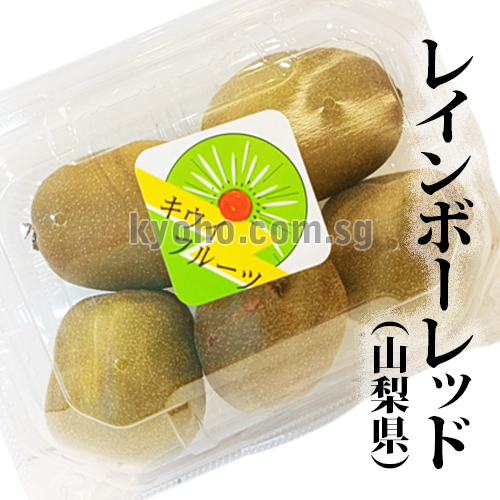 |
 |
 |
| GF/OTR-039: | GF/OTR-040: | GF/OTR-041: |
| RED KIWI Yamanashi Prefecture (5pcs / approx 300g) |
RAINBOW RED KIWI Shizuoka Prefecture (6pcs / approx 110g+/pc) |
RAINBOW RED KIWI Shizuoka Prefecture (18pcs / approx 110g+/pc) |
 |
||
A rare variety, only available for about a month, and one of the biggest in the world!It is a variety bred by crossing an apple variety with a male Chinese kiwifruit variety.It was named Sanuki Gold after the golden kiwifruit with flesh developed by Kagawa Prefecture, and the variety was registered in 2005. Weighing around 200g per fruit, it is one of the largest kiwifruit in the world, and has a sugar content three degrees higher than Hayward, making it a golden kiwi with rich juice and a melon-like texture. |
||
 |
||
| GF/OTR-042: | ||
| SANUKI GOLD KIWI Kagawa Prefecture (8pcs / approx 2kg) |
||
 |
 |
|
| GF/OTR-053: | ||
| SANUKI ANGEL SWEET (KIWI FRUITS) Kagawa Prefecture (9pcs / approx 1.4kg) |
||
栗 / CHESTNUT |
||
 |
||
| GF/OTR-029: | ||
| FRESH BIG CHESTNUT (TOP PREMIUM GRADE) Ehime Prefecture (3L size / approx 500g) |
||
 |
||




























